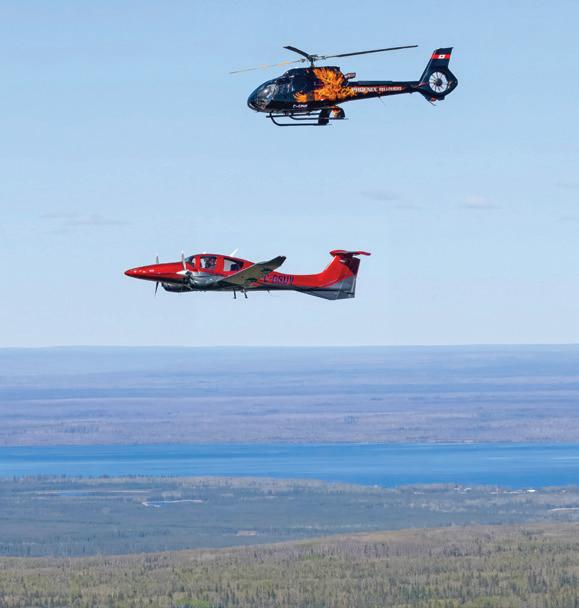
WOP MAY’S MERCY FLIGHT
PEI’S CABLE HEAD AIRPARK




DEPARTMENTS
50
FEATURES ON THE COVER
Phoenix Aviation’s Airbus H130 (EC 130) together with their Diamond DA-62 near Fort McMurray, Alberta. See page 30 for story. Photo by Greg Halinda
Robert S. Grant

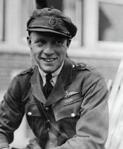








50
Phoenix Aviation’s Airbus H130 (EC 130) together with their Diamond DA-62 near Fort McMurray, Alberta. See page 30 for story. Photo by Greg Halinda
Robert S. Grant




Canada has a rich and proud aviation history — from the pioneering bush pilots who connected remote northern communities, to world-class aerospace innovation and training. Supporting a Canadian aviation print magazine helps preserve and celebrate this legacy while fostering future growth and awareness within the industry.
First, print aviation magazines offer indepth stories and historical features that digital formats often fail to match. They provide an immersive experience, encouraging readers to slow down and engage with content in a more meaningful way. For aviation enthusiasts, professionals and hobbyists, print remains a valuable resource for learning and inspiration.
Second, a Canadian-focused aviation magazine ensures that our unique
perspectives and achievements are not overshadowed by international narratives. It highlights Canadian pilots, aircraft, companies and events — stories that might not otherwise receive attention in American or other global publications.
Moreover, supporting such a publication strengthens the national aviation community. It connects readers from coast to coast to coast, showcasing regional events, airshows and aviation schools. This fosters pride and promotes networking opportunities across the country.
Finally, in an age of shrinking newsrooms and growing media monopolies, independent print magazines face immense challenges. Supporting a Canadian aviation magazine means supporting Canadian journalism,

storytelling and specialized knowledge. It’s an investment in an informed and inspired aviation community.
Whether you’re a pilot, engineer, student, or simply a fan of aviation, backing a homegrown aviation publication helps keep our skies — and our stories — alive and thriving.
And we need your help. I urge all our current subscribers to gift a oneyear subscription to Canadian Aviator magazine to a family member, friend or acquaintance with an interest in aviation. Use this code for a 50-percent discount off the regular price*: D5AAAAAA. New subscribers are entitled to this special promotion too. See the masthead opposite for subscription contacts. Valid until August 31, 2025.
*Valid for new subscriptions only.


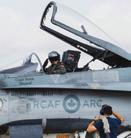
I have just read "True Patriot Love" in your Airmail section of the May/ Jun 2025 issue. I want to congratulate David Dickens of Monterey, Calif. for his excellent taste in aircraft. I, too, with a fellow pilot, owned a 1965 (or was it a 1962?) Cessna 150 based in Saint John, New Brunswick. That was back in 1984 to 1988. I loved flying that little bird and treated many friends and family to joy rides in it. Many parts of New Brunswick passed under my wings, as did the Bay of Fundy while crossing over to Nova Scotia and the Northumberland Straight, as I eagerly crossed over to Prince Edward Island for a totally different landscape view.
Since then, I have been a dedicated hangar flyer, and Canadian Aviator keeps me on course.
Harold McKinnon, Quispamsis, N.B.
Just to mention that in the latest issue of Canadian Aviator (May/Jun 2025), Graeme Peppler’s Pep Talk article titled “Aviation Miracles” mentions that Lausanne, France is where the Fédération Internationale de l’Aéronautique is based. Lausanne is located in Switzerland (or Suisse for us French-speaking people). Lausanne is also the headquarters for the Comité International Olympique.
Always interesting to read the magazine from beginning to end.
André Charbonneau, Mont-Tremblant, Qué.
Lausanne is of course in Switzerland. France was accidentally inserted during the editing stage. This editor should know this geographical fact, having once visited the beautiful city on the shores of Lake Geneva (known as Lac Léman in French). – Ed.
In August of 1971 I was a member of the RCMP and transferred from Gold River, British Columbia to Sidney, B.C. In September I started flying lessons towards obtaining a commercial pilot licence. I was looking for a flight instructor and someone recommended Rick. I can still remember to this day when I first met Rick across from the B.C. Government Air Services Hangar at the Victoria Airport. At the time I arrived in Sidney, I did not know that Rick Cockburn had flown his Harvard in the London to Victoria Air Race.
That September I started my flying lessons towards the CPL and Rick was my instructor. We became great friends during this time. He took me up in his Harvard and demonstrated rolls and other aerobatic manoeuvres. It was during this time that he told me all about his adventures flying in the air race and the finish over Race Rocks in Victoria.
In 1973 I was accepted into the RCMP’s Air Division flying all over Canada, including the Canadian North. I retired after 33 years and flew overseas until I turned 65. Rick and I have remained friends until this day.
I also want to say how much I enjoy reading every issue of Canadian Aviator. There isn’t an issue that I don’t read about someone I know or stories about places I have flown.
Garry McIver Kamloops, B.C.
Send us your letters. Canadian Aviator welcomes reader letters on topics of concern to Canadian pilots and the aviation industry. Please be brief, to the point and polite in your submissions. Email Steve Drinkwater steve@canadianaviator.com

Ever lose a GPS signal on your device while in the cockpit? Want something that is more accurate and dependable than the GPS feature of your iPhone or iPad? Garmin offers a remote antenna, the GLO-2, that captures not only the U.S. military’s GPS signals, but also the Russian GLONASS signals, offering redundancy, especially in this era of undependability of our supposed ally to the south. The GLO-2 links to as many as four different devices via Bluetooth and updates itself up to 10 times faster than the GPS feature found in most smartphones and tablets. Battery will stay charged for up to 13 hours, and it comes with a USB charging cable. About C$180. Learn more at, and available from, garmin.com

Do you want others to be able to track your flight’s progress on a map? Would you like to know your wheels-up and wheels-down time precisely? Would you like to receive
maintenance reminders when they come due? All these features, and many more, are available through Airbly of Charlottetown, Prince Edward Island. The Phoenix Aircraft Monitor is a small, black box that measures about 94 x 94 x 28 mm (3.7 x 3.7 x 1.1 in.) that sits on your aircraft’s glareshield and communicates via satellites. Ideal for aircraft fleet operations.
About C$429. Reporting services start from C$99/year. Learn more at, and available from, airbly.com
From the makers of the XGPS150A Universal GPS Receiver comes the XHUD1000 Head Up Display. Designed especially for light, general aviation aircraft, the XHUD can display one of three selectable modes: AHRS, which displays altitude, airspeed, attitude, bank angle and compass heading; Traffic, which displays ADS-B traffic on a radar style graphic with selectable range, using TCAS symbology; and Tablet Graphics, which displays graphics from separate apps running on a tablet or smartphone (e.g. AHRS, synthetic vision, maps). It is compatible with both iOS and Android devices, using Wi-Fi and Bluetooth technology. It is compatible with Foreflight and other Electronic Flight Bags (EFBs). About C$860.
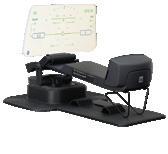
Learn more at dualav.com. Available from aircraftspruce.ca
Father’s Day may have passed already, but you don’t need that excuse to pass up the opportunity to gift the aviator in your family with a pair of socks sporting an aviation theme. Perhaps a stocking stuffer come Christmas? The socks are of a polyester and Spandex blend and are machine washable. One size fits all. About C$5.50. Learn more at, and available from, temu.com/ca


As Remotely Piloted Aerial Systems (RPASs) — often referred simply as drones — continue to proliferate, more and more responsibility lies with the drone operator to conduct operations in a safe manner, particularly with respect to more conventional aircraft that may be operating in the same airspace. While helicopter operations come to mind, the fact that light airplanes and ultralights are legally permitted to fly as low as 500 feet above ground level (agl), or 1,000 feet agl in built-up areas, they also have the potential to come into conflict.
uAvionix, the market-disrupting American company that brought low-cost ADS-B solutions for light aircraft, has introduced a new product to aid drone operators by alerting them to other aircraft that are close to the drone operations area.
Meant as a wearable device for the RPIC (Remote Pilot In Command) or an associated observer, skyAlert will provide a real-time audible and visual alert when an ADS-B Out signal-emitting aircraft enters a zone that the drone operator defines. That zone can be set for range and altitude limits. Both 978 MHz and 1090 MHz frequencies are detected.
Electronic Flight Bags (EFBs) such as Foreflight, FlyQ, SkyMap and many others are supported through industry-standard GDL-90 protocols.
This device only works when approaching aircraft are transmitting an ADS-B signal. Although there is still no mandate for ADS-B Out in Canada for operations in Class C, D and E airspace, the adoption rate for the installation of ADS-B equipment in light aircraft is nevertheless relatively high given the enhanced flight safety it provides.
uAvionix was founded in 2015, initially to develop miniature avionics systems for drones, hence its name uAvionics, the uAv being the acronym for Unmanned Aerial Vehicles, another name for drones. In 2022, the company was sold to DC Capital Partners LLC.
STRUCTURES TECHNICIANS
Northern Alberta’s Portage College has announced a new certificate program that will train students in Aircraft Structures. Graduates will be able to gain entrylevel employment leading to a career as an Aircraft Maintenance Engineer - Structures (AME-S). The program is set to begin next year and will be based at the Cold Lake Regional Airport (CEN5). Portage College’s aim is to provide trained technicians to serve in civilian roles not only at nearby CFB Cold Lake (home to 4 Wing, the RCAF’s largest fighter aircraft wing), but elsewhere in the country.
In partnership with Portage College, the City of Cold Lake has purchased a hangar at their regional airport and is converting it into a state-of-the-art training facility.
“This hangar will house the first iteration of the Cold Lake Aircraft Maintenance Engineering School, which would be a big win for our community and our partner, Portage College,” said Mayor Craig Copeland. “With the aerospace and defence industry operating in our community and a strong relationship with 4 Wing over the past 70 years, there are many potential partnerships we can leverage as this project takes shape.”
The city has set aside additional adjacent land to allow for expansion of the facility should the college expand its aerospace-related offerings to include aircraft maintenance,

engineering, and perhaps flight training. Portage College plans to eventually offer a full program.
“At Portage College, we are thrilled to partner with the City of Cold Lake on expanding into the aerospace sector,” said Nancy Broadbent, president and CEO of Portage College. “The establishment of the Aircraft Maintenance Engineering program marks a significant milestone for both our institution and the community.” The program has also received official endorsement from the Minister of Defence.
The Aircraft Structures Technician program will be broken down into seven modules:
• Introduction To Aviation Structures
• Metal Aircraft Construction 1
• Metal Aircraft Construction 2
• Special Processes/Practices
• Composite Fabrication/Repair
• Damage Assessment/Repair 1
• Damage Assessment/Repair 2
The college will begin student intakes in October of 2025, with first classes beginning in August 2026.
Portage College’s main campus and headquarters is in Lac La Biche, Alberta and it has several other campuses spread around Northern Alberta communities, including several First Nations.

There is likely no Canadian who has not heard of the de Havilland Beaver, given its iconic status in Canadian culture. Most would be forgiven, however, if they assumed it was the first Canadian-designed bushplane. For it was not.
In 1935 Dutchman Robert Bernard Cornelius “Bob” Noorduyn designed the Norseman to fulfill a Canadian-defined mission: A heavy load-hauling, single-engine high wing monoplane to facilitate float operations and the easy loading of passenger and cargo on airport ramps. First flight was on November 14, 1935.
The design proved to be popular, and many served in both the RCAF and in U.S. military forces during the Second World War. In fact, it was the first Canadian-designed aircraft to serve with U.S. forces. Six iterations were built over a 25-year production span, totalling over 900 airplanes. Initially they were produced by
Montreal-based Noorduyn Aircraft Ltd., later by Canadian Car and Foundry, also of Montreal.
The first Norseman, powered by a Wright R-975-ES Whirlwind radial engine, was sold to Dominion Airways and registered as CF-AYO. During the summer of 1941, American film production company Warner Brothers leased it for a starring role alongside James Cagney in Captain of the Clouds, with filming done around North Bay Ontario. CF-AYO met its demise in Algonquin Park in 1952, and its wreckage is on display at the Canadian Bushplane Heritage Centre in Sault Ste. Marie, Ontario.
A trivial, but nonetheless interesting fact about the Norseman: It was first designed with floats. Later iterations were fitted with skis before finally evolving into a landplane on wheels.
SHOULD FLOCK TOGETHER – OR SO I THOUGHT
Then this ebony bird beguiling my sad fancy into smiling,
By the grave and stern decorum of the countenance it wore,
“Though thy crest be shorn and shaven, thou,” I said, “art sure no craven, Ghastly grim and ancient Raven wandering from the Nightly shore — Tell me what thy lordly name is on the Night’s Plutonian shore!”
Quoth the Raven “Nevermore.”
— Edgar Allen Poe
Iwalked down to the dock at about seven one morning. I had a flight pre-arranged to take off at eight o’clock with six passengers to three destinations. About 40 minutes of flying time would be involved. The Beaver’s floats needed pumping, the oil checked, and fuel added. I was giving myself an hour to do these tasks and, with any luck, would have enough time left over to check the phone recordings for other bookings called in during the night.
The walk from the house had taken a pleasant 10 minutes. The North Island weather does not promise the kind of morning that was now greeting me. It was a delightful dawning with no rain for a change, nor any feel of a Nimpkish blowing out of the valley of the same name behind the townsite; it was a soft quiet morning.
Then suddenly, the raven that lived on the balustrade over the entrance to the ramp let out a loud screech and flew at me as if to attack. This wasn’t just a scolding like most mornings, but a statement of ownership by what I had thought earlier to be a bird who acknowledged our mutual domicile and place of work. We had been living in peace together, each conducting our flights from the seaplane dock here at Port McNeil.
Our seeming affinity, each as aviators, one with feathers the other with

less airworthy materials, was now in question. I ducked from his advancing dive, which turned out to be a feint and ended with a clever bird-only type roll off the top as he regained his footing on the crossmember above. I viewed a hostile glint from the black eye in that head that was now cocked in a fashion as if to favour hearing from only one ear.
I felt, rather than viewed, the bird’s unwavering hostility following me down the dock to the moored seaplane. I determined immediately the reason
for this unexpected hostility: The last bilging port on the Beaver’s dockside pontoon was missing its stopper — one of those happy little red, white and blue rubber balls used in the child’s game of Jacks that seaplane pilots found to fit so conveniently snug would now be a prized item of theft in a raven’s nest.
As I cut one of the other balls in half and shared it with the empty port, I could not resist the temptation and stated loudly for the bird to hear, “Thus spake the Raven Nevermore.”
The Kremlin felt a strong need to impress the world with its flight capabilities, especially the Germans and Japanese, whose sabre-rattling was becoming an increasing concern. In 1935 a decision was made to attempt a non-stop flight from Moscow to the western United States. However, the only aircraft available was the ANT25 whose range was only 1,900 miles, a lot less than required for the proposed 5,674-mile flight.
In 1929, Russia had successfully made a flight to the U.S. with a Russianbuilt Junkers K 37, but stops were made in Siberia, the Aleutians and in Alaska before its arrival in Vancouver, Washington, across the river from Portland, Oregon. The Soviets therefore consulted with that crew to determine what possibilities were available for the planned 1937 flight.
At this time Stalin ordered Sigismund Levanevsky to proceed to the U.S. and take delivery of a float-equipped Vultee aircraft and fly it back to Russia via the British Columbia coast, Alaska and Siberia. On this August 8, 1936 flight, Levanevsky stopped for two days at uninhabited Goose Island, 25 miles southwest of Bella Bella, B.C.
Stalin had also decreed that Valery Chkalov would pilot the June 1937 nonstop flight, and not Levanevsky as previously planned, likely because he was born in Poland and Stalin wanted this record-setting flight to be made by a Russian.
After consultation with the North Sea Route administration (NSR) and Tupolev, the Kremlin made a decision that, even though the nonstop flight was not possible, the use of deception would allow the appearance of the nonstop flight. Previously, on July 13, 1935, an official request for the flight had been made for the ANT-25 to land in the U.S. Stalin, either directly or
through his embassy in Washington, D.C., requested logistical and moral support in his clandestine endeavour.
Franklin D. Roosevelt (FDR) was president from 1933 to 1945. He was no fool and could see the value of supporting Stalin’s regime as a buffer to the militaristic threats of Adolf Hitler.
FDR also had a staunch ally in William Lyon Mackenzie King, who had been educated at Harvard University and the University of Toronto, and whose mother was an American. Member of Parliament King was swept from office in 1911, and he later returned to the U.S. where he was retained as a
“... Stalin ordered Sigismund Levanevsky to proceed to the U.S. and take delivery of a floatequipped Vultee aircraft and fly it back to Russia via the British Columbia coast, Alaska and Siberia.”
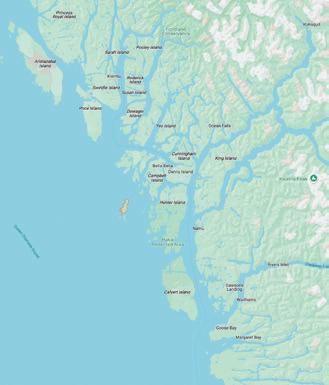
consultant by John Rockefeller, Jr., who allowed him to continue his work with the Liberals in Ottawa while working with Rockefeller’s interests in the U.S. King first became prime minister in 1921 and again from 1935 until 1945. Prior to taking his position, he had discussions with American academic and businessman Clarence Decatur (C.D.) Howe, who agreed to stand for Canadian office and, after his election in 1935, became Minister of Transportation.
So we can see that, when in 1936 FDR made a simple request to his Canadian counterpart for the government of Canada to turn a blind eye to the Soviet’s use of an uninhabited island off the West Coast to refuel an
aircraft that was supposedly making a “nonstop” flight from Moscow to Vancouver, Washington, it would not be a problem, especially since FDR was to monitor the situation by providing onsite assistance to ensure the secrecy of the project. FDR, John Rockefeller Jr. and American big business were calling in some of their markers.
In a very short time, the U.S would be providing $32 billion in “lendlease” aid to the Soviet Union. The manufacturing giants of America were destined to make huge profits, regardless of whether the Russians paid off the debt or not.
FDR was responsible for the creation of the Civilian Conservation Corps, or CCC, during the Great Depression
to provide paid work for unemployed young men. In 1937, a number of these men, who were Native Americans from Alaska and Washington state, were recruited to proceed via a government vessel and assist in the refuelling of an aircraft at an unidentified West Coast location. Frank Eyle, from Charter Oaks, Washington, was a member of the group who later described the project as the best job he ever had.
On Monday, June 14, 1937, in Seattle, Soviet agent Vartanian had made radio contact in code with the group at Goose Island and advised them to expect a message on June 17 concerning the arrival of the ANT-25.
To be continued...



What an amazing world we live in when it comes to technology. The power packed into small devices these days was only in the imagination a few decades ago. Now it’s taken for granted by most of us. Those of us who have been in the industry for a while have watched a variety of technologies, probably most notably GPS, take a couple of decades to take root and grow. Thirty years ago, acceptance of GPS for IFR navigation was in its infancy. These days, very few airplanes fly without it.
Back then, aircraft snaked across the sky in crooked routes using ground-based NAVAIDs for guidance. Conflicting aircraft were commonly vectored around each other by controllers where radar coverage existed. All of this required a controller’s attention to ensure separation. These days, aircraft capable of accurate point-to-point navigation can reduce controllers’ workloads by flying routes that keep them separated. Sometimes ATCinitiated shortcuts can solve conflicts requiring minimal monitoring.
In the old days, a pilot might choose a route by looking at a map and seeing items like restricted or danger areas that should be avoided. Most flight planning utilities don’t have algorithms or databases to recognize these areas and plan around them. Interestingly, the software often chooses routes arbitrarily with waypoints, and it often leads to some surprising route descriptions. They often resemble the time-honoured, traditional zig-zag paths.
spell waypoints correctly to ensure the correct course.
These Mandatory Routes come in many forms. Some are strictly for departing one airport and landing at another. Others are departure routes to get you out of one airport to a point where the pilot is free to choose the rest of the route. Similarly, other routes are for arrivals within a particular region, where the route to get there is not published, but effective for when the aircraft is approaching the destination.

As good as this technology is, there are downsides to all of this that must be kept in mind.
Probably the most prominent issue from an ATC viewpoint is related to flight planning. Aircraft are capable of direct routes over long distances, and now flight planning software and websites have advanced to amazing capacity. One trouble with this is that pilots often allow the software to pick a route without scrutinizing what was chosen.
ATC facilities publish routes for IFR pilots to file to help the flow of air traffic. These are called “Mandatory Routes” and are found in the planning section of the Canada Flight Supplement. They exist for a reason. Some pilots simply file direct, and let ATC reroute them if necessary. This lazy flight planning results in increased workload for controllers, and “heads down” time in the cockpit, as the controllers must issue clearances on new routings. Entering a new route can take time and care must be taken to
Arrival routes often include Standard Terminal Arrival Routes (STARs), but not all airports that have Mandatory Routes have published STARs. Case in point, the Saint John, New Brunswick airport has restricted airspace merely 14 nm northwest, and there are routes published for approaching from various directions to aid a pilot in flight planning around that airspace, rather than filing direct and going through it. While these routes are normally established for IFR flights, VFR pilots may consider them as guidance, as well, since they may be published for effective use of airspace and for safety considerations. It is fairly common to see a departure out of an airport file fixes associated with STARs, using them as enroute waypoints. Also, arrivals using fixes published as departure routes occur. With a little thought, one can see why this might not work well. Almost invariably, these aircraft end up getting rerouted due to opposite direction
“As with every piece of technology, we must remember there are traps that are often easy to fall into. If you’re not aware of how the technology works and what its limitations are, you may be taken by surprise.”
traffic. Another reason to look for a Mandatory Route.
Many of the flight planning websites have another issue. One pilot files a route, and whether it’s an acceptable route traffic-wise doesn’t matter. As long as there are no spelling errors in the fix names, the site saves it for recommendation to other pilots who use the same software for the same airport pairing. This, in effect, propagates the offending route and then it becomes self-validating. “Look how many pilots file flight plans with this route.”
With all those pitfalls in mind, I’ve watched GPS go from being barely accepted to being mainstream navigation. Something once used questionably for aircraft navigation has now become part of every aspect of flying, from departure and enroute navigation to flying high-precision and high-efficiency instrument approaches. Instrument approach procedures can be established even at smaller, remote airfields where ground-based technology is difficult to install and costly to maintain.
As with every piece of technology, we must remember there are traps that are often easy to fall into. If you’re not aware of how the technology works and what its limitations are, you may be taken by surprise. Understanding how it should be used, and the effects of using it improperly, can make all the difference to flight safety.
Like the Calgary-Edmonton rivalry, there is a lesser-known strife in aviation: pilots and mechanics. While the conflict doesn’t necessarily exist to the same degree at all companies, I’m fairly certain it’s a universal relationship — or lack thereof.
Most AMEs will “bag on” pilots for writing lazy snags, refusing to fly a perfectly safe airplane, and nitpicking problems that are likely due to “finger issues”. Meanwhile, pilots will scoff over a mechanic’s vague rectification (“ground-tested serviceable” or “unable to duplicate”), the spite or mockery involved in persistent troubleshooting, and their promptness to jump for an MEL (Minimum Equipment List).
Somewhere in the middle, where it’s hazy and grey and constantly overcast, is the ominous land that belongs to the pilot-mechanics, or mechanic-pilots, depending on which profession they associate themselves with first. These confused folk (I would know, I’m one of them) don’t really belong to one specific side of the battle.
Instead, we sit in dark hangars with grease on our hands and swear we won’t be the type of pilot that wrote up whatever is giving us a headache in that moment. And then we find ourselves on the ramp during a preflight walk-around cussing about whichever mechanic signed the very bald tire as serviceable.
Occasionally, the dewpoint is at the exact right temperature, and the pressure in the oleo is perfect, and maybe
the moon is in a specific phase, so all the pilots and all the mechanics end up sharing a beer together. Those moments are exhilarating and stressful because we can simultaneously joke with everyone and offend everyone at the exact same time.
As a pilot, I’ve flown some questionable airplanes. I’ve experienced stuck brakes and jammed flaps and crosswinds in a small trainer that made my knees shake when my feet touch solid ground. Every time I take off, I have the utmost faith in my engineer that the plane they’ve certified is going to bring me home safely. I would never second-guess another pilot’s decision for not flying.
As a mechanic, I’ve witnessed a plane with physical holes in the leading edge fly as required. I’ve taken apart a propeller hub that has too-few ball bearings and damaged seals and cracked flanges, that still ran like a dream. I’ve seen first-hand what these planes are capable of, and I’ve watched them deliver despite the worst circumstances. Yet I would absolutely never hand over a plane that I wasn’t 100 percent confident in.
At the end of the day, both pilots and mechanics will call home to say they’re going to be late, delayed due to maintenance. None of us are happy about it, we all want the plane to take off on time and land as scheduled.
Aerial firefighting, I found, was one of the few places where pilots and mechanics (typically) got along seamlessly. There was no “my plane” vs “your plane,” no petty complaints and no blame game. We were a team,
“Every time I take off, I have the utmost faith in my engineer that the plane they’ve certified is going to bring me home safely.”
away from home base with nobody but each other, doing our absolute best to benefit everyone.
Whenever anyone asks if I recommend aerial firefighting, I always say absolutely. But then I recount a nightmare shift because it is not for the weak.
You begin your day at 08:00 with a blaring alarm (that will leave you with the resemblance of PTSD years later) alerting of a dispatch. You help the pilots ready the planes — chocks, covers, tie downs — and then you see five of the six of them take off. The last one is having oil temperature problems, so as soon as the responding planes disappear you grab your tools and get to work. The planes return a few hours later while you’re elbow-deep in the engine and you must tend to them, assisting with refuelling, completing a walkaround and performing quick maintenance — a burnt-out bulb, perhaps a quick tire change. Then engines start, you wave goodbye, and back to the broken plane you go.
You scarf down a quick lunch with dirty hands and get the oil cooler removed just as the planes are coming back again. The cycle repeats until the sun begins to set and they must land for the night. One returns with a flutter in the flight controls, another that isn’t making rated power, and one pilot mentions — although not urgent, he insists — that his air conditioning isn’t working. You worked all day in the blistering sun which you know means his cockpit is hotter, so it’s absolutely a priority even though he promises he’s okay. Thankful for the cool breeze the night brings, you don your headlamp and divide the work with your other

mechanic, each tackling a plane. It’s after midnight before all the planes are serviceable, with fresh foam, clean windscreens and no snags in the book. Now it’s time for engine runs. You return the broken plane to service at three in the morning, pack up all your tools, drive home and collapse into bed.
Four hours later, you get a dispatch, and you do it all over. At least you’re not beginning the day with a broken
plane this time, you remind yourself. But aviation loves a good jinx and when the planes return for a refuel, one pilot reports a leaking tank. You grab your tools and, more importantly, your caffeine and get to work, the cruel reminder that, at the end of the day, at least the pilots get to go home. You then consider a career change, that maybe you should be a pilot-mechanic instead of a mechanic-pilot after all.
NORTHERN ADVENTURES WITH MICHAEL BELLAMY
Helicopters demand an attentive pilot, someone who is mechanically intuitive when sorting through signals the engine or the flight controls are sharing. The indications can be subtle, like a new vibration, or a temperature or a pressure needle a width from where it normally resides. Those habits gradually become ingrained to where the slightest change will grab your attention.
Jodie Granley, Chief Pilot for the Edmonton Police Service, recently related an incident where a caution light started flashing, indicating that the Ni-Cad battery on her Hughes 500 was “over-temping.” Anyone familiar with nickel-cadmium batteries knows just how prone they are to overheating, including the possibility for them to catch fire or even explode. Her immediate action was to shut off the master switch. She then changed course, heading for a braided river course a few miles away. Granley reached to the floor just ahead of her seat, opening the battery access door. The battery was indeed hot.
Landing on a gravel bar, she rolled the throttle to idle but kept the engine running. Wearing gloves, she disconnected the battery, then carefully lifted it out and carried it to the water’s edge. Partially immersing the battery in the cold water, she returned to the machine and patiently waited for it to cool. Once done, Granley reinstalled the battery and flew back to base. What impressed me about Granley was the logic of her actions. I’ve heard of other circumstances where pilots simply landed, shut the machine down, vacated the helicopter and waited for help. Not Granley. Once she landed back at base, she sought out the engineer to nonchalantly report what had happened with the hope a new battery could be installed before her next trip.

Leaving Fort McMurray, Alberta early one Sunday morning, I had a ‘hung start’ with the Allison C20B engine in an Alberta Forestry Bell 206 Jet Ranger, meaning the N1, or compressor, during the start sequence refused to accelerate fully into the idle range. Twisting the throttle above the detent, I managed to encourage it and completed the start. I didn’t have passengers but was heavy with fuel and cargo.
I continued with the warmup and preflight, all appearing normal. Advancing to flight idle, I decided to go. “Good morning, Tower. Fox Sierra Alpha is ready for departure northbound.” Tower came back with the clearance, and I pulled up into a hover. A quick instrument scan — all normal — and I accelerated to 80 knots in the climb.
At 400 feet I felt the machine twitch, which instantly brought me back to the gauges. N1 (compressor) indicator was hunting a bit, which pulled me over to the TOT (turbine outlet temperature)
to see that it was following. Another abrupt yaw with needles splitting even further, I dumped the collective — panel caution lights were flashing.
I keyed the mike with, “Tower, it’s F-S-A, I’ve lost my engine.” Looking ahead, there was a rough field alongside the highway. The engine continued to surge violently as I tried to control the yaw with pedals. I rolled the throttle off. With an open stretch with deep grass ahead, I ignored the panel as I judged the flare — I’d have to run it on. We slid onto the long grass, but hidden just ahead was a shallow ditch. I locked the cyclic into a firm grip as I had visions of skidding into that ditch where the blades would take the tail boom off.
We came to a stop nose-down, and the machine rocked on the uneven ground. Silence! Switches ‘Off’, I popped the door open. Across the narrow field there was a parking lot for what looked like a hardware store. A couple of men were standing at the door curiously looking at me. I swung
my knees back inside and turned the master back on. The radio came to life with tower “F-S-A, its tower — say again?” Once I responded affirming my safety and location, I walked around the machine. All appeared okay. No visible damage. Giving the tail rotor a turn backwards, there was an ominous metallic noise coming from the engine.
A few minutes later, the RCMP arrived and, with their help and with rope from the cruiser, we pulled the 206 back a bit to where it was not so precarious. From then on, highway traffic lost interest. The officer asked for a written explanation, and I wrote, “Shortly after takeoff, a mechanical problem was experienced. I landed to investigate and decided not to continue the flight.”
The next day, Barry Cornfield the engineer arrived with another engine and soon I was back on the job. Investigation showed that a main bearing in the compressor section had failed. That compressor wheel now sits on my desk as a paperweight.
Another close encounter with a 206 occurred when delivering engineers to a large gas compressor station in northern Alberta. The winds were strong and gusting. I elected to fly directly to the helipad in a slow, descending approach over the maze of white gas piping. Once on the pad and the collective down, my passengers opened the doors and, gathering tools, headed towards the maintenance shed.
Something was wrong. The engine was still at flight idle, but the engine
was spooling down well below the ground idle speed. I gripped the throttle, ensuring that it was still wide open, but the engine was slowly decelerating. There appeared to be a white mist coming from the side of the engine cowling. I tightened the controls and stepped out to open the cowling. Jet-B fuel was spraying everywhere in the engine bay. I didn’t waste any time, shutting down the engine and, once secure, I went back to investigate. The Fuel Control Unit intake pipe had a broken flange on the ‘B nut’, which luckily happened just as I landed. I looked at the myriad white gas pipes that I had just flown over, visualizing the explosion I would have caused had I crashed into them. My angel was certainly with me.






AEROBATICS WITH LUKE PENNER
YES, IT’S POSSIBLE WHEN SEATED IN A COCKPIT!
In a previous column, I briefly alluded to a setback I encountered during last year’s training season — a physical injury that forced me to reevaluate how I approached preparation, recovery and risk in competitive aerobatics. This article is the story behind that moment, and the lessons I took from it as I prepare for what might be the most ambitious season of my flying life.
In the months leading up to the 2024 U.S. National Aerobatic Championships, I was pushing hard to fine-tune my Unlimited-level figures. One particular challenge had been gnawing at me: the vertically ascending negative snap roll. More specifically, a left-rotating snap roll on a vertical upline, initiated with right rudder — opposite the foot I’m used to using for that kind of figure. For whatever reason, these negative snaps in the vertical plane have always been profoundly disorienting for me.
Despite flying aerobatics for years at a high level, I couldn’t seem to wrap my head — or my muscle memory — around how to make this specific figure work cleanly and consistently. The snap would either break unevenly, or the airplane would yaw and tumble in ways I didn’t intend. I knew I needed to master it if I wanted to be competitive at Unlimited, so I committed to months of focused practice.
Eventually, I started to get it. The breakthrough came after relentless repetition, review of onboard footage, and careful attention to energy management and control inputs. But in the runup to Nationals, time was scarce. The Unlimited catalogue is so vast that you can only allocate so much bandwidth to a single figure. I moved on, trained the rest of the catalogue, and left the “other direction” snap for another time.
That “another time” arrived last year when I decided I needed to become ambidextrous in snap rolls, particularly on vertical uplines. I went up to practice
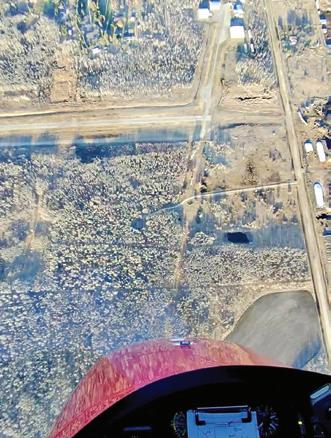
the right-foot, left-rotating, vertical negative snap, but I made a critical error: I didn’t fully commit. I hesitated during the initiation, never reached a proper accelerated stall, and then applied rudder anyway (all of this happens in a fraction of a second). The airplane jolted into an awkward, violent motion and, in the process, I hurt my back.
What followed was massage therapy, chiropractic work, stretching and grit — trying to stay in competition shape while managing a lingering and painful injury. I did make it through the Nationals, and I’m grateful for that. But it wasn’t pretty, especially as I hobbled away from the airplane after a flight. Anyone who has dealt with back pain
knows how limiting it can be, especially in a high-G, high-focus environment like an aerobatic box. The physical strain of Unlimited flying leaves no room for compromised biomechanics.
That experience stuck with me. Over the winter I kept thinking about the mistake — not the technical one in the airplane, but the strategic one in how I approached the manoeuvre. I had gone at it with urgency and ambition, but without a fully structured plan. And I had paid the price.
This year I’ve taken a different approach. As I write this, I’m one week away from my first major training event of the season, working with a French coach who’s flying to North America to help prepare several of us for a longterm goal: representing our countries at the 2026 World Aerobatic Championship in New York.
With just a month to prepare at home before that coaching camp, I set out to shake off the rust and rebuild my G tolerance. But front and centre on my training plan was that snap roll — the one that injured me last season. I knew I had to face it again.
I built a gentle progression. I started light, limited the torsional G-load, reviewed every flight using 360-degree onboard footage, and analyzed each attempt for timing, attitude and control coordination. After six or seven flights, something clicked. I found the missing piece in the transition between the pitch and yaw elements, and the figure began to feel… not easy, but possible. Consistent. Repeatable.
And that’s when the fear really showed up. The mental residue of last year’s injury was still there. My brain remembered how it felt to walk away from a flight barely able to bend down and untie my flight shoes. But, step by step, I pushed through it — not by ignoring the fear, but by addressing it systematically.
That’s the real lesson here. Fear has a place in aviation. It reminds us of what’s at stake. But it can’t be allowed to guide the aircraft. You don’t conquer it by pretending it isn’t there — you do
it by preparing carefully, learning from your mistakes and building systems that allow you to progress without rushing.
This spring marks the beginning of a new phase for me. I’m looking at the biggest challenge I’ve ever taken on in aerobatics: a two-year campaign to the World Championships. It’s daunting, yes, but it’s also deeply motivating. The journey to New York in 2026 will involve countless training flights, competitions on both sides of the border, and the occasional setback, without doubt.
But if there’s anything I’ve learned from that snap roll, it’s this: progress isn’t about being fearless — it’s about being focused.
In my next article, I’ll report back on how the training camp went, how the first contest of the year unfolded, and what lessons I’m already pulling from this season. My eyes are on the Canadian and U.S. Nationals later this year, with the hope of earning a place on Canada’s Unlimited team.
See you in the box.

ACessna 180 water-flying trainer operated by Lake Country Airways of Orillia burbled away from a slightly splintered dock at Constance Lake, west of Ottawa. A teenage girl, whose father occupied the left seat, turned to me and asked if float airplanes could fly from regular airports. She listened wide-eyed to my descriptions of dolly takeoffs and landings on grass and gravel airstrips until her father returned with a fresh seaplane rating on his private pilot licence.
The little lady’s interest sparked remembrances of a well-known and respected bush pilot from years ago who regularly enthralled fellow aviators at Red Lake’s Lakeview Restaurant. Born on August 12, 1935, in the Northwestern mining community, colourful and witty aviation pioneer Hartley Weston sometimes reminisced and laughed about his frights launching floatplanes from dilapidated platforms after spring breakup. A glance into my files indicated that the scary process still continues, especially with light airplanes south of the Canada-USA border.
Numerous anecdotes appeared in flying forums and water-flying posts. One wily individual sprayed a Piper PA-11’s floats with soapy water as well as his grass airstrip. Another fastened Teflon to a plywood sheet and used a truck to reach takeoff speed. (The airplane fell off the plywood.) A similar enthusiast slid his aircraft down a sloping 900-foot airstrip with ditches on both sides and later announced to attentive compadres that everyone should experience the fun and “…stripe your shorts at least once.”
Hartley and I kept in touch over the years. In his honour, the correspondence we exchanged resided
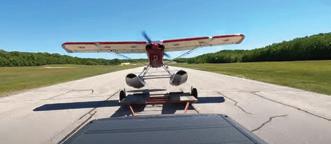
in my filing cabinet long before his passing in 2009. Rereading old times after the visit to Constance Lake, I noticed he had flown dozens of types, from scrubby Cessna 180s to glamourous Beechcraft 18s on wheels, floats, skis and wheel-skis. Weston likely held an unofficial record for more dolly takeoffs than any pilot in Canada. He seemed possessed with inner instincts to extract more performance from wings and engines than modernday flight school graduates fingered from their number-crunching handheld computers.
Typical dollies came with two large rear wheels and two smaller units at the front. Helpers shuffled the candidate onto a wooden platform and attached a lightweight cord to one float with the opposite end secured to a springloaded brake handle. At liftoff, the cord activated the brake, and the dolly stopped. Not infallible, the contraption sometimes wobbled out of control and sheared runway lights before running out of momentum.
Towed to the runway or airstrip, most operators disconnected the tow bar, although with slower aircraft, pickup trucks pulled the platform to
flying speed. Before starting the run, the pilot placed the control column forward and waited for adequate airspeed and elevator control before full throttle. Positive climb prevented damage to the truck roof or the dreaded danger of plunking onto the departed surface. An American launch did not go well.
“I hauled butt to 55 mph, and he gunned the engine and yanked in a couple notches (of flap). He lifted and wobbled a little,” the truck driver said.
“I was staring in the mirror when the trailer started to fishtail. I slowed down like an idiot and my son hit the deck of the truck because those floats zoomed right over his head.”
Weston’s career, which began with a war-surplus Tiger Moth registered CF-FUG, included many airplane types on wheels, skis, floats and wheel-skis. No prior training or checkout methods existed for dolly procedures. With twin-engines, asymmetric thrust from the Beech 18’s 450-hp Pratt & Whitney R-985s eased directional control. The massive 47-foot, 7-inch wing and electric 45∞ flap (maximum) added to the safety picture and dolly departures averaged 70 mph. After slugging through
days of slush and whiteouts, Weston described a “hairy” event which caught him by surprise.
Tow bar removed and power applied to the 6,800-lb Beech 18, acceleration seemed normal. Weston readied to apply standard 15∞ flap when an earthquake-like tremor shimmered the airframe. A follow-up “God-awful” bang blurred his world. Before Weston had time to ponder, he realized blue sky no longer filled the windshield. Instead, he had been thrown from the dolly into a near-vertical position with forward view changed to asphalt gray. Beechcraft did not normally assume extreme attitudes.
“At such times, one does not have the luxury of protracted analysis; one responds to the emergency by slamming throttles wide open while simultaneously hauling back on the control column,” he said. “With the aircraft barely assuming level flight, the floats made heavy contact with a resounding crunch, causing the aircraft to ricochet back into the air, vibrating like an oversize tuning fork.”
Milliseconds from converting into a collection of crumpled metal and Weston’s body parts, the tail lowered but airspeed hovered on stall. The low-wing Beechcraft and flap produced enough lift to remain airborne until speed reached a safe balance. The unplanned runway contact damaged both float bottoms and rear support struts, so he returned to car-
ry out a grass surface touchdown. Weston deduced that a malfunctioning brake unit caused a “tire-burning premature halt and threw him into the air. The return to earth, he acknowledged, made his nerves “more twangier.”
On final, Weston maintained a nose-up attitude as slow as could be managed. When the Beech settled, he applied maximum power and pulled the controls brutally back to the stops. Instead of flipping, the aircraft rocked several times in clouds of grass blades and earthworm-infested turf. “Beeches sure were tough buggers,” he concluded.
During the era of Canadian-designed Noorduyn Norseman dominating wilderness skies, the fabric-covered freighters with cabins reeking from moose blood and pike scales returned for changeovers to skis. Pilots like Weston preferred calm mornings or tranquil evenings without unfriendly crosswinds. Compared to most airplanes, Norsemans, cautioned Weston, called for extra expertise and no gentleness when the moment arrived for full and abrupt throttles.
“Approach no more than a couple hundred feet a minute carrying power. As one begins contacting the grass, more power is slowly and carefully applied as shock and deceleration slams one forward in the harness,” said Weston. “As weight on the grass be
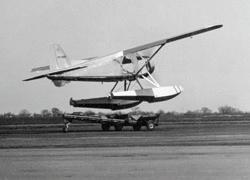
comes greater, you rapidly decelerate, and throttle must be fed to the stop as the aircraft comes to a shuddering halt. The Norseman was the only one that consistently left me weak in the knees.”
Weston added that Norsemans had little tendency to flip upside down if “…one kept their cool and power on with full back elevator.”
Weston’s intense interest in northern flying began when, as a toddler, he wandered from his Red Lake waterfront home and pulled himself onto the air services’ docks. During late teenage years, he earned a private pilot licence and bought a de Havilland DH.82C Tiger Moth. To help pay for it, he cleared the front cockpit and installed a plywood floor to haul trappers and native people. Experience gained, he flew numerous more powerful bush planes in all conditions and weather situations. Weston fought off sled dogs in a Fairchild F-11 Husky and survived a flesh-tearing Beechcraft 18 hilltop crash. Employers depended on his skills to test fly rebuilt airplanes and called him first to move changed-over aircraft from decrepit dollies. His dedication enabled others to prosper while he stayed in the background. Today, no monuments or plaques mark his contributions. At least contemporaries still residing in the aviation community of Red Lake still watch Hartley Weston’s skies.

YES, AND IT CAN SAVE YOUR LIFE
Pilots universally dislike surprises. They are stressful at best, and harmful at worse. This aversion often keeps us close to familiar playgrounds. Come summertime though, the temptation to venture away pushes us to tackle new destinations and environments, heightening the potential for unwelcome surprises like an unexpected obstacle on short final or an unusual micro-weather system that we don’t detect until too late.
Meticulous flight planning, sometimes spanning hours, is necessary to mitigate these risks. The military, which thrives on procedure development, has a mnemonic to organize the process: OUTCAST. The approach is transferable to all flight operations with some adaptations.
O: Operating Area. Begin with a broad overview of the route and the airfields. A few years ago, that meant laying down miles of sectionals and flipping through hundreds of pages of aeronautical data. Today, there are numerous apps and Electronic Flight Bags (EFBs) available to facilitate and enhance the task. You can even ask Artificial Intelligence (AI) to tell you about your planned flight, but it will remind you that it is only trying its best and you are ultimately the pilot in command. Then, delve into specifics. Where are the destination and alternate airfields in relation to nearby landmarks? What types of approaches, visual and instruments, are available? What is the runway orientation, length, width, elevation and slope? What is the runway current condition? What is the taxiway layout, and how will you navigate from touchdown to parking? Online aviation communities can be a great source of “local knowledge”. Picking up the phone and speaking with the locals at your planned destination remains a tried-and-

true approach to gaining insights.
U: User. This is about mission goal and support, people-wise. Who are you meeting, and where? Is the mission critical? Can it be achieved by alternate means? If you will take passengers, do they have any specific needs? Do you have ground transportation arranged? What about food, customs, fuel, parking/hangar space? What fees are involved? Are services like oxygen or maintenance available? What about WiFi or cell service availability?
T: Terrain. This remains critical, especially given the heightened risk of Controlled Flight Into Terrain (CFIT) accidents near airports. Leverage satellite photos and 3D imagery to “see” the route and facilities ahead of time. Inflight videos available online can also be useful. Are there nearby towers, power lines, or high-tension wires? Keep in mind that things can change. NOTAMs are still highly relevant to safety. Will the terrain influence weather patterns, potentially creating wind
funneling or wind shears? What is the Minimum Safe Altitude (MSA)? Is density altitude a concern?
C: Communication. Who do you need to contact along the entire route and how? Does the destination airport have a control tower, and what are its operating hours? If not, where is the closest towered airport? How will you obtain the latest weather? How will you close your flight plan? What services can you expect? If you need to pick up an IFR clearance or cancel a flight plan, how will you do so? Is the airfield frequented by aircraft like gliders or agricultural aircraft that might not be on the common frequency?
A: Airspace. What classes of airspace will affect your route and your destination airfield? Do you have the required equipment and a backup plan should the equipment fail? Are there overlying airspace restrictions you need to be aware of? What about Temporary Flight Restrictions (TFRs)? Are there any Special Use
Airspace (SUA) areas nearby that require consideration? What are their activation times and altitudes? Are there any non-standard circuit procedures, such as right-hand traffic, or unusual altitudes? Are there any unique procedures published in the CFS or in NOTAMs?
S: Sunlight. Here, we consider the level and quality of lighting available. What are the precise sunrise and sunset times for your arrival? Will you be operating directly into a rising or setting sun, a potential blinding hazard? If operating at night, what is the lunar phase and illumination percentage? Is there surrounding unique lighting that might help visual identification of the airfield? What type of lighting does the airport have, and how is it activated (e.g., pilotcontrolled lighting frequencies)?
T: Threats. Consider anything that may constitute a hazard to your operations. Are there parallel runways or oversized taxiways that could cause confusion on arrival? Are there
any runway or taxiway "hot spots" requiring extra caution during taxiing? Are there nearby airfields with similar runway layouts that might lead to misidentification? Is there specific traffic to be particularly aware of, such as high-speed military or airline operations, or significant traffic from a nearby flight school?
The OUTCAST mnemonic provides a robust framework for pre-flight preparation. It helps to proactively identify and mitigate risks through thorough planning, but not eliminate them entirely. Equipment failure or adverse weather can throw a wrench in the best laid out plans. Taking the time to analyze all angles of an upcoming flight will not only help avoid surprises if everything goes as planned, but it will also allow you to be better prepared to successfully adjust the plan should the need arise. Ultimately, a systematic approach to flight preparation will help you build the confidence to expand your flying range safely.
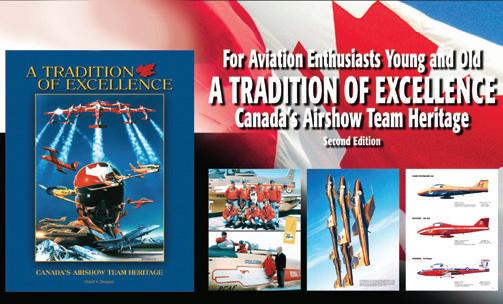
768 Pages – 1,800 Photographs
Order your copy today at aviatorsbookshelf.ca (see page 51)

ONCE LONG IGNORED, NOW OF VITAL IMPORTANCE
Flying an aeroplane requires that pilots be alert and disciplined. They must be in full command of their physical skills and their cognitive functioning must be at its sharpest.
It goes without stating that pilots should, as best as they reasonably can, be free of any conditions that would be detrimental to their alertness, their decision-making and their reaction times when flying. Should any of these human factors be lagging, for whatever reason, perhaps in the presence of such matters it’s best to refrain, temporarily, from being seated behind the controls of an airplane.
The types of factors which are best known to crop up as hindrances to piloting are physiological. Most often this entails serious heart and cardiovascular issues. Certain other physical conditions
such as epilepsy, uncontrolled diabetes or other insidious medical problems which might cause sudden incapacitation can either temporarily or permanently render a pilot unfit to fly. Other health problems such as acute infections are transitory and, while affecting one’s immediate ability to fly, they’ll not disqualify pilots from holding their licence in the way that an acute or chronic issue could.
While a pilot’s physical health has, forever, been the determining criteria for medical fitness to fly, lately there’s been increasingly open talk of a health issue that has long been swept under the carpet: mental health. While being every bit as crucial to one’s flying preparedness, it’s perennially been relegated to the background, stymied by the stigma and sensitivity associated to its breakdown not being amongst the characteristics that
a pilot is ostensibly supposed to have.
Mental health encompasses one’s cognitive, behavioural, social and emotional well-being. It plays a pivotal role in daily life, fostering how individuals balance the daily demands placed on them, how they cope with stress, pressure, decision-making, relationships, etc., and how likely they are to reach the goals and potential towards which they may be aiming. It’s a measure of an individual’s capacity to act in ways to achieve a higher quality of life.
Being a pilot is unique. For the professional, it entails unorthodox work schedules. It means being away from home, and from family, for frequent stretches of time. It likely involves dealing with frequent time zone changes to which one is constantly having to adapt. And there’s the constant pressure required to
maintain the highest levels of professionalism and safety. For the airline pilot, the burden of responsibility to a cabin full of faithful passengers, in and of itself, can induce significant stress: you, as pilot, shoulder the responsibility of their safety. You have to perform at your best; passengers simply sit there, completely reliant on you, your skills and your sense of wellbeing on the day. The lifestyle can, and does for many, take a toll.
Several warnings signs are identifiable as mental health flags. A change in personality is one: someone who doesn’t quite “seem like themself” may be evidence of a mental health matter. Uncharacteristic behaviour, irritability and moodiness may be another. An increase in occupational mistakes, and/or evidence that the individual is struggling with decision-making could be another symptom of trouble. Withdrawing socially or expressions of being overwhelmed should raise flags in the minds of others
that someone in their sphere is facing challenges with which they could use some professional help.
Be it from flying itself or from other factors running their way through one’s life, a not insignificant percentage of pilots — air traffic controllers, technicians, ground personnel and cabin crew too — are subjected to stress, anxiety, depression and other mental issues at various times. The impact on the individuals concerned and, by extension, on flight safety, is emerging as being a vital component towards which the industry is proactively applying recognition and treatment paths.
The stigma surrounding mental health, not least in the aviation field, has traditionally resulted in barriers to assistance for those for whom their mental state is low. For pilots suffering from mental health problems, three themes that work against their addressing of it are: (1) their fear that discussing it will result in




repercussions, (2) they generally distrust the confidentiality of reporting systems, and (3) their belief that the reporting of it will devastate their careers. All of this has resulted in a culture of whispers if not of outright silence.
With such inhibitive factors in mind, various aviation and pilot advocacy groups have been studying how the industry could better deal with mental health. The effort is, thus, now growing to properly foster an environment that places mental well-being on a par with physical health. So, for pilots faced with mental health challenges, the industry is now proactively working at ways to lighten their path to health. The stereotypical days of pilot-jocks born of physical and mental steel are being consigned to the mythology that has always been their reality. People face mental health challenges. That’s the reality, and aviators are no different. Long may a more holistic approach be cultivated.





July 26, 1965, at Constance Lake, a little lake located adjacent to the Ottawa River and about 30 kilometres northwest of the then CYOW Uplands Airport, was the first time I was in a float-equipped airplane, and I was obtaining my seaplane endorsement. The aircraft was a 1955 PA-18 Super Cub, CF-JPK, which is still on the Canadian aircraft registry and shows that it operates out of White River, Ontario. My instructor, and owner of the Cub, was the renowned Russ Bradley of Bradley Air Services. He formed the company just after the war in 1946. Russ and his partner, Weldy Phipps, were pioneer arctic aircraft operators and the first to use Super Cubs on arctic tundra tires, which allowed them to
land almost anywhere on the arctic barren lands. Bradley Air Services went on to become First Air which, in 2019, morphed into today’s Canadian North and services our Canadian Arctic communities with a fleet of jet and turboprop aircraft.
For those of you who are not familiar with the Super Cub, the seating is tandem with the student sitting in the front and the instructor seated behind in the back seat. This two-hour initial flight started out with some air work to demonstrate the handling characteristics of the aircraft fitted with floats. I was instructed to demonstrate a stall. Part way through the manoeuvre I received a fairly sharp smack on the back of the head with the admonishment of, “Whoever
showed you how to do a stall like that?” Hmm, not so sure that instructional technique would go over very well in 2025, but 60 years ago it was apparently an accepted practice.
That first flight on floats led to 42 years of flying on the water and about 6,000 hours of flying floatplanes and amphibians, including two seasons on the venerable twin engine Grumman G-21A Goose flying boat. My theatre of water operations was primarily on the lakes and rivers of Quebec, Ontario, Labrador and British Columbia. Salt water operations included Hudson Bay and the Arctic, Atlantic and Pacific Oceans. During much of my early aviation career, and in later years as a sideline occupation, I was a floatplane
training and check pilot and provided advanced float training in a variety of seaplanes.
Most seaplane pilots operate in a single-pilot capacity and often operate in remote and challenging conditions. It is imperative that these individuals be prepared to operate safely in a myriad of changing environments. My job was to prepare these pilots for these operations. Hunters, fishermen, tourists, campers, medevac patients, indigenous families, geologists, miners, foresters, firefighters, big-city commuters, business tycoons and captains of industry were, and continue to be, part of the seaplane pilot’s clientele. Seaplane pilots need skillsets that go far beyond those of their wheeled-plane counterparts to provide safe conditions for themselves and their passengers.
Glassy water, rough water, small, confined lakes, ocean swells, tidal currents, marine harbours, fast-flowing rivers, shallow lakes, floating debris, shoals and reefs are all considerations that the pilot must consider prior to takeoff and landing. An imperative skill that the seaplane pilot must develop is the ability to read the wind on the water. When landing, taking off, docking and/or mooring, the seaplane pilot must always be cognizant of the wind, much more so than their landplane counterpart. Water operations are unforgiving and a hard landing or a landing with even a little side drift can result in disaster. Taxiing a light airplane on land, in high winds, can sometimes be a challenge but when taxiing on the water in these conditions, it takes an entire new set of skills to do so safely. Water taxiing must be done very slowly or conversely very fast, and this latter mode is referred to as “step taxiing.” Turning in and out of wind techniques can differ significantly, depending on the type of aircraft. In a twin-engine turbine aircraft that has reversing capability, like in the Twin Otter, it can be a piece of cake. Turning a piston Single Otter, with its large tail surfaces, can be a major challenge and requires type-specific techniques. So far, we have considered takeoffs,

landings and taxiing, but the goal is to put your passengers and/or cargo safely ashore and then depart again, and this is another whole dimension. Docks or floats that are specifically designed for seaplanes are few and far between. More often than not there are other challenges such as marine craft, pilings, protruding sharp objects, waiting to puncture delicate pontoons, and a host of other challenges. Currents, tides, winds, children, dogs and well-meaning “lookie-loos” are other factors.
When operating in wilderness conditions, docks are nonexistent and sandy beaches with the right slope are a rarity. More often than not there are trees right down to the shoreline and the shores are infested with sharp rocks and boulders. Ramps and suitably sloping shorelines to taxi amphibians up are another story. Another skill that is not used very much anymore, but pilots should be cognizant of, is the ability to tie up to a buoy. Also, how to use an anchor in fast-flowing rivers, or to ease one’s aircraft back on to a windward rocky shoreline. These are almost a lost art but were used in remote high wind situations. Ropes, rope handling, and fuelling on the water in remote locations must also be learned. Another topic not yet touched on is the carrying of external loads, the most common being marine craft.
To the uninitiated, all these challenges, and more, sound rather
daunting and maybe discouraging. Not so. When these skills are mastered, the floatplane pilot is as professional as the airline captain shooting an approach on a dark and dirty night in a large transport aircraft. Just different skills. Christmas Eve, 2007 was my last day in the office before retirement. In the hangar below were a couple of King Airs, a Twin Otter, a couple of helicopters and a Cessna 206 on amphibious floats. Well, I was the boss and there had to be some perks to this job that I was leaving. I had made arrangements to keep on flying in retirement, but this would likely be my last opportunity to do my favourite type of flying. I took it, and the Queen paid for the gas. The office manager had never been in a floatplane, so I piled her into the Cessna and I took off from CYVR and flew up to Pitt Lake and shot a few last touch-and-goes on the water. You can do that on the West Coast in December.
After landing back at the international airport I gave the floats a little pat and hung up the float flying forever. I still have fond memories of the water, the wilderness, the myriads of lakes, rivers and coves that I have landed in over the years. These are just memories now, but I hope this little story may inspire some young and upcoming pilots to venture into the world of flying off the water. In doing so I wish you all the old bush pilot’s blessing: “May you have tight floats and tailwinds.”
A REVIEW BY RENÉ R. GADACZ
BY MICHAEL VLESSIDES
If you’ve ever found yourself on the ramp at -30°C with numb fingers and jet fuel on your coveralls, Michael Vlessides’ The Ice Pilots will feel familiar. But even if your aviation experience is limited to sunnier latitudes or more modern cockpits and flight decks, this book offers an engaging and gritty look into one of Canada’s most legendary northern operations: Buffalo Airways Ltd., based in Yellowknife, N.W.T., Hay River, N.W.T. and Red Deer, Alta.
Best known to the public through the History Channel series Ice Pilots NWT, Buffalo Airways is more than just reality TV; it’s an all-weather, no-nonsense company that flies freight, fuel and passengers in some of the oldest airworthy aircraft still operating commercially. Vlessides, a writer and journalist, embedded with the crew for several seasons and, bitten by the Buffalo bug, delivers a firsthand account that is part memoir, part historical retrospective and all aviation passion.
The book follows the seasons of Buffalo’s unique operations, beginning in the bone-cracking cold of a typical Yellowknife winter, moving through spring’s melt and breakup and into the high-paced tempo of wildfire season. Each chapter is anchored in specific events: supply runs, medevac flights, mechanical issues, training days, latenight maintenance and fire suppression missions. Vlessides uses them as launch points to explore deeper stories of the people, the aircraft and the ethos of northern bush flying.
The heart of Buffalo Airways is Joe McBryan (“Buffalo Joe”), founder and patriarch, whose aviation credentials and sheer personality need no introduction in Canadian aviation circles. Vlessides does a fine job of capturing Joe’s contradictions: his Luddite stubborn
insistence on doing things his way, the sharp temper that creates tensions for those around him, the deep loyalty to his crew and customers and the unshakable love for the ships under his care. He is the kind of owner-operator who still flies, still wrenches and still sets the tone for the entire company.
Vlessides also spotlights key figures in the Buffalo crew — chief pilot Arnie Schreder, the ever-calm veteran presence in the cockpit; up-and-coming rookies learning to tame taildraggers in high winds; mechanics working miracles in improvised hangars at remote gravel strips. Aviation professionals will appreciate the inside look at these people’s day-to-day work, from the challenges of keeping radial engines (“piston pounders”) humming in subzero conditions to managing fuel logistics on the edge of nowhere.
The book also shines a spotlight on the younger generation of pilots, some barely out of flight school, who come to Buffalo Airways seeking adventure and the all-important flight hours. Unlike their peers elsewhere, these rookies learn to fly in some of the most demanding conditions, often with outdated instruments and minimal technology. Most don’t last long, surrendering to the cold or the intensity of the work.
One of the book’s real strengths is the respect it pays to the aircraft. The Douglas DC-3, DC-4, Curtiss-Wright C-46 Commando (a.k.a. “Dumbo”) and Lockheed L-188 Electra are more than just machines in Buffalo’s hangar; they are characters in their own right. Vlessides writes with reverence about these airframes, detailing their Second World War heritage, quirks, strengths and the painstaking maintenance required to keep these ships in the air. There is a particular satisfaction in seeing these classics continue to earn their keep in

a world dominated by digital cockpits, AI-assisted flying, GPS and composite skins. By documenting the continued relevance of analog systems and handson experience, The Ice Pilots challenges dominant narratives of technological progress and so celebrates a form of flying that is increasingly rare.
Readers familiar with aircraft systems and flight operations will find plenty to sink their teeth into. Vlessides doesn’t bog the narrative down with jargon, but neither does he shy away from describing the nitty-gritty: startup procedures on a frosted-over DC-3, dealing with carb icing at 8,000 feet, emergency repairs in subzero temperatures and firefighting sorties in Canadair CL-215’s (a.k.a. “the Duck”) and Lockheed’s Electra dropping 12,000 pounds of water every few minutes on Yukon wildfires. These aren’t just anecdotes; they are reminders of the skill, judgment and resourcefulness required to fly in the North.
There’s also an underlying respect for aviation culture throughout the book. Whether it’s the hangar-floor banter, the rite-of-passage ‘checkouts,’ or the campfire storytelling that always fol-
lows a good scare, The Ice Pilots captures the language and lore of pilots “who fly by feel.” Vlessides is honest about the risks, the mistakes and the hard lessons learned. Near-misses, fuel miscalculations and mechanical failures are all part of the job and part of the story.
That said, the book never loses its sense of admiration for the job these crews do. The North demands a different kind of flying — low, slow and often without much margin for error. Buffalo pilots often operate under pressure most modern operators would find unthinkable: weather that can turn on a dime, short gravel runways, non-existent instrument landing systems (ILS) and cargo that simply can’t wait. This is a world where good stick-and-rudder flying still matters, where checklists are memorized, not programmed and where customer relationship management (CRM) happens face-to-face, not over VHF.
The Ice Pilots is more than a tie-in to a television show; it is an ode to Canada’s northern aviation history and heritage and those still living it. If you ever have the chance to look at Buffalo Airways’ vintage Douglas DC-3 (C-GWZS, one of nine) that you knew flew on D-Day, dropping paratroopers over Normandy, or knew that their Douglas DC-4 (C-FBAA, one of 13) was used in a recreation of the historic 1943 Dam Busters raid over Germany and would feel awe, this book will resonate.
In a time when aviation is becoming increasingly automated and risk-averse, The Ice Pilots reminds us of a different kind of flying: hands-on and high-stakes. This book is worth the read for anyone passionate about Canadian aviation, classic aircraft and the realities of Arctic and sub-Arctic flying. Buffalo Air is alive and well and, since Vlessides’ book published 13 years ago, the company has expanded its current 62-aircraft fleet to include a Boeing 737-300, among others.
The Ice Pilots: Flying with the Mavericks of the Great White North
By Michael Vlessides
Douglas & McIntyre, 2012, 271 pp. Available from The Aviator’s Bookshelf (aviatorsbookshelf.ca)










Just weeks away from my 66th birthday I found myself — yet again — a student of flight. Strapped in beside me was Cameron Spring, the operations manager for Phoenix Heli-Flight, based at CYMM in Fort McMurray. Situated on the floor between us was the Airbus EC-120 Colibri helicopter’s right seat collective lever, which I was pulling up, ever so slowly. To counteract the twisting force of the rotor, I gently input cyclic pressure and pressed on the anti-torque pedals, remembering (just in time) that most European helicopter rotors turn opposite to those on the Bell 206 Jet Ranger I’d once flown. We wobbled a bit at first, then lifted into a hover.
Even after a 17-year hiatus from flying helicopters, surprisingly enough came back for my instructor to move his hands far enough away from the controls for me to notice. For the next 48 minutes, I practiced hovering, landings and takeoffs on the CYMM apron, and then again onto a still-frozen Clearwater River. Cameron went so far as to let me recover at their base, flying an approach through a gap in the forest before turning 90 degrees, touching down on a pad in front of the Phoenix hangars, more-or-less properly aligned. It was an amazing experience, reminding me how much I enjoy helicopter flight.
But the truly glorious, nearly one-hour flight down rotary-wing lane wasn’t the reason for my returning to the city I once called home during the mid 1980s. Paul and Andrea Spring, the owners of Phoenix Heli-Flight, had recently added a brand spanking new Diamond DA62 airplane to their fleet of 11 helicopters, expressly for the purpose of transporting flight crews during fire season. On assignment from Ed McDonald’s JetPro Consulting, my job in Fort McMurray was to help Cameron garner a multi-engine instrument ticket, and the same, preceded by a multi-engine rating, for their chief pilot Steve Harmer.

Cameron Spring learned to fly with the Air Cadets and has logged nearly 4,700 hours in helicopters (which industry credits at a 3 to 1 ratio when compared to equivalent fixed-wing experience). He first graduated with a degree in Business, then went on to complete his Commercial Helicopter Licence before joining the company his parents built from one leased helicopter and rented hangar space.
Phoenix’s Chief Pilot Steve Harmer’s story is a little different, earning his rotary wings in the British Army. Besides serving in several war zones, Steve also has the distinction of having flown with the Blue Eagles, the British Army’s fling-wing equivalent of the RAF’s Red Arrows. Even knowing Harmer has over 11,000 hours of rotary time, seeing photos of him inverted in a Westland Lynx helicopter still gave
me chills, as did the thought of them both slinging loads and long-lining huge buckets of water over raging forest fires. What I had to offer could only be seen as tame in comparison.
As I milled about Phoenix’s three spotless hangars waiting to fly with Cameron and Steve, I chatted with their friendly pilots and in-house AMEs. But more than immaculate helicopters and truly happy employees, what struck me most was the company’s focus on flight safety. Each of their nearly dozen helicopters are equipped with cockpit voice, video and telemetry recording gear. The information these systems record is reviewed daily by a dedicated in-house manager, a sort of flight safety watchdog. On one occasion the data was used to exonerate a pilot who was initial-

ly thought to have accidentally pickled a load. Not only did the video prove the pilot wasn’t the cause of the inadvertent release, but it also helped identify an incorrect wiring of a switch on the cyclic control, the result of an external maintenance contractor’s error. Regarding dogs, four rescue pooches roam the Phoenix hangars freely, a testament to the treatment of everyone in the company, including four-legged ones, as family. Equally amazing were these two professional helicopter pilot’s progresses given the compressed curriculum I’d prepared for them. Steve started each day with standard multi-engine sequences: stalls, manoeuvring at reduced airspeed, engine problems and assorted system failures, all culminating in a return to base for a simulated single-engine instrument approach and landing. Cameron, already holding a multi rating, launched directly to all variety of holds, ILS, LPV and LNAV approaches.
Along with learning to fly a new type, mostly on a simulated single engine aircraft, the two aviators had to work through the intricacies of the Garmin G1000 NXi GPS navigator — plus its tiein to an equally sophisticated autopilot and flight director system. To make things even more interesting, consider that helicopter and airplane flight controls have very little in common. Pull back on the stick of a DA62 and resulting nose up attitude and addition of power will make you climb. To duplicate that manoeuvre in a helicopter, you first push forward on the cyclic to accelerate the aircraft while pulling up on the collective to initiate a climb, all
the while doing a foot dance on the anti-torque pedals. As for control pressures, the rudder pedal force required to control direction during simulated engine failures in the DA62 are amongst the highest I’ve encountered in light twins. Stomp on the pedals of any helicopter in a similar fashion and you’re likely to depart controlled flight.
With the basics learned in McMurray, we deployed to Josephburg airport CFB6, just northeast of Edmonton, to train in the airspace the two would flight-test in by week’s end. The next five days were a mix of flying test profiles, combined with an intense review of IFR rules of the road. Harmer completed his multi-engine rating on the final day but was delayed in taking his IFR ticket ride owing to weather. Spring rode out weather conditions best described as the airborne equivalent of bull riding, earning his multi-engine instrument rating by day’s end.
In the end, what was it that contributed to the success of two highly accomplished helicopter pilots earning their advanced fixed-wing credentials in record low hours? The first was the breaking down of required IFR exercises into bite-sized pieces, starting with basic aircraft handling. Then, little by little, we connected those pieces in the context of fixed-wing flight, namely departures, cruise, holds, approaches and missed approaches. But the real force-multiplier I witnessed daily was the preparation focus, and work ethic both Cameron and Steve brought to their training. These attributes alone are the markers of true professionals.


BY ROBERT S. GRANT
Smoke slipstreaming backwards from a struggling shape appeared above the sharp-lined horizon. Touchdown took place seconds later on a cleared airport runway and fire rescue vehicles followed. Soon, the burned-out aircraft fuselage faded from the banks of screens and observers in the virtual control tower relaxed. They had become absorbed in the realistic scene and for a few moments, worried about the non-existent crew and passengers. The drama of professional voices and prompt exchanges in a simulated control tower demonstrated the partnership between Montreal’s Canadian Aviation Electronics Inc. (CAE) and NAV Canada’s cadre of keen aviation experts. On January 17, 2025, the two concerns inaugurated this innovative air
traffic services training centre. On the city’s 8585 Côte de Liesse, the purpose-built site depended on real time interactive simulators, sterile classrooms and dedicated members from both associations.
In 1974, Transport Canada developed a 75-acre training institute at Cornwall, 248 miles northeast of Toronto. On November 1, 1996, newly founded non-profit NAV Canada remitted $1.5 billion to Transport Canada and accepted responsibility to manage the air transportation system, including recruitment and training traffic controllers and flight service specialists. The facility fulfilled its purpose as the NAV Canada Training Institute (NCTI) and graduated more than 25,000 students until COVID-19 decimated the international transportation industry. NAV Canada sold the

buildings housing its training centre and other facilities in 2022. Canadian Aviation Electronics Inc., created by ex-RCAF Kenneth Patrick in 1947, also prospered. Export and domestic successes continued through several acquisitions, flight simulator production, and even a health care division. Far-sighted managers recognized that civil aviation training markets exceeded simulator sales and decided to venture into untested fields. Today, CAE instructs more than 120,000 pilots yearly in distant markets such as Korea and Vietnam with more than 13,000 employees in 71 centres.
When the COVID-19 pandemic slowed, recovery of air transportation occurred, but commercial organizations faced serious staff shortages. In NAV Canada’s case, retired employees

and school closures left gaps. Air traffic increases surfaced and new and returning airspace users entered Canada’s 18 million square kilometres of controlled and uncontrolled flight regions. The company needed to raise personnel levels through a revised training pipeline and addressed future capacity with CAE to narrow the disparity void.
Qualified applicants to NAV Can’s carefully-designed and safety regulator-approved curriculum have been accepted. NAV Canada still trains nearly 60 percent of students and will eventually instruct 100 percent for final phases and plans
augmenting training capabilities. Methodologies employed to train aviation professionals internationally could be transferred to bringing additional controllers and flight service specialists online in Canada. Strategic agreements with CAE formalized on April 16, 2024. NAV Canada anticipated recruiting nearly 500 extra students within four years to operate centres and stations from eastern Canada’s lobster-packed waters to British Columbia’s whale-watching paradise.
The arrangement enabled NAV Canada to launch an instructor-coach hiring binge to move student intake upward with CAE’s

advanced training delivery and learning sciences outlined by Marie-Christine Cloutier, VP of Civil Strategy, Performance and Marketing. The long-term investment allowed NAV Canada as an Air Navigation Service Provider (ANSP) to concentrate on primary airspace management, technical reporting and document supply. Classes near Pierre-Elliot-Trudeau International Airport commenced at the new facility in October 2024.
Applicants to NAV Canada’s cadet-like programs were informed that background in aviation or higher education degrees were not prerequisites. Career seekers,

however, needed a high school diploma and be 18 years of age with Canadian citizenship or Permanent Resident status. English remained compulsory although candidates destined for Quebec needed bilingual backgrounds.
After acceptance, aspirants entered an instructional program which stands as one of the longest career paths in aviation—as long as 36 months. The job, explained NAV Canada’s Vanessa Adams, Government and Media Relations, demanded exceptional spatial awareness, memorization of codes (transponders), and aircraft call signs. “It’s meant to be hard,” she added. From first to last day, no potential graduate considered the concentrated weeks as simple boring strolls through lifeless blocks of airspace. Maintaining track of dozens of blinking dots and yellow lines with clicked buttons and memory tricks is not an easy task. Instructors from both sides of
the partnership possessed in-depth backgrounds and brought decades of personal experience to the fast-paced workplace. They understood pressures involved in maintaining aircraft separation and when to recognize moments of fatigue in themselves or workmates. Fostering essential communications with proper phraseology between groundbound staff and pilots became paramount. Initially, students train 37.5 hours per week within CAE classrooms for sessions ranging from 4.5 to 6.6 months and develop instinctive skills in state-ofthe-art simulators before release to exercise new knowledge in specific units across the country.
“I think it makes us better at training pilots as well because now we understand the challenges both with the controllers and pilots which is better for leading towards a safe airspace,” said CAE’s Stella-Marissa Hughes, a Training Centre leader. “In
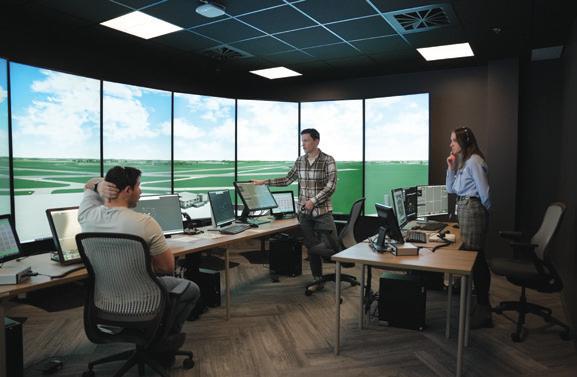
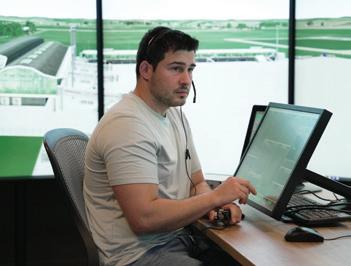
the moments that matter, those students will have to know how to perform so the simulators are an amazing tool to be able to get our students to practise.”
Twenty-two instructors deliver lectures based on NAV Canada’s innovative curriculum and field-tested courseware with small-size classes along a “digitalized training journey.” Poor habits and hazardous tendencies are probed and nullified as quickly as possible. Snap decisions such as halting dangerous runway incursions or calling missed approaches because of runway debris or airliner conflicts will be refined. NAV Canada teams often surveil as many as dozen aircraft on multiple tracks and altitudes depending on their work units. Assigning altitude changes throughout Canadian Domestic Airspace, maintaining speed limit orders such as 250 KIAS below 10,000 feet and coordinating with adjacent sectors fall within their bailiwick. No one leaves their station unmanned even for snappy bathroom breaks. Everyone from freshly graduated high schoolers on their first job and non-aviation workforce members are encouraged to reach out and ask and ask again.
“We are basically information gatherers and passers of information. In tense times, pilots want weather and landing data for the nearest airport and need to know what services are available,” explained instructor Daunica Brock whose controller experience extended
from Edmonton as far as the extreme Arctic islands. “Our students need to find that and know the moment to ask questions and when to notify the low-level groups who, in turn, would start talking to tower controllers.”
Medical emergencies rate as the most common irregular situation. Controllers and Flight Service Specialists not only provide information; they query on their own initiative. Ground staff acknowledge whether the aircraft is a 533,519-pound Airbus 330 or a 10-passenger Pilatus PC-12. If a request for immediate descent and landing occurs, runway size will be confirmed and unique requests or circumstances addressed. In one case, an airliner north of Edmonton asked to be cleared direct to Los Angeles. Another wanted right hand turns only after losing navigation capabilities.
“You don’t want to overstimulate with too many questions. Pilots may be dealing with cockpit checklists and doing their own planning or may not intend to descend right away,” added Brock. “But on the flip side, pilots need to have that empathy with the controller.”
Exact placements are not known on the day of recruitment. Newhires are evaluated for postings in one of Canada’s seven geographically-zoned flight information regions. Evaluators consider more than
“We are basically information gatherers and passers of information.”
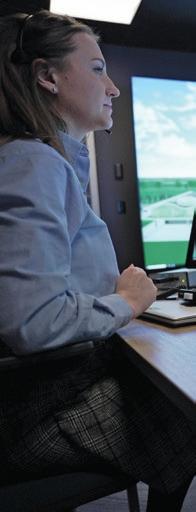
technical competency. Personality plays an important role to avoid clashes within confined towers or windowless Area Control Centres which could tumble down to flight cancellations, delays or forgotten airplanes. Although pilots understand the concept of Cockpit Resource Management (CRM), identical principles apply to NAV Canada teams assigned side-by-side during stressful shifts.
“We’re not doing operational training at CAE but preparing for on-the-job so when they come out of here and move on to their respective unit, they’ll know the
basics and will be further trained,” explained Brock. “They’ll know procedures and understand adjacent sectors and units before proceeding from a generic airport to learn their own specialty. We want that transfer to be truly seamless.”
When considered cognizant of the responsibilities of what Ottawa-based Manager, Aeronautical Information Management (AIM) Product Assembly Amanda Devine called “Highways in the Sky” after as many as 6 ½ months of paid on-the-job monitoring, area and tower controllers can expect as much as

$193,660 annually. Air traffic controllers average base salaries of $151,000. Aerodrome Advisory Specialists at locations such as Gatineau-Ottawa Executive Airport maximize at $114,468 and airport advisory personnel anticipate $118,953 per year. Location incentives add to the package.
Media often glamourize the men and women who crew control towers, direct aircraft from start-up to shut-down and guide and monitor them safely through enroute structures and special use airspace for military activities, parachuting or local flight school aircraft. The public tends to overlook the critical functions of Flight Service Specialists, many of whom situate in remote communities. These individuals do not assign routes, altitudes or speeds. Purposed to interpret meteorological data for weather briefings or advisories, they become major components in NAV Canada’s safety package. Beyond Montreal’s digitalized airconditioned kingdoms, flight service specialists absorb local terrain knowledge and weather peculiarities. British Columbia’s mountainous regions, for example, differ from Labrador’s coastal gales and forecasts sometimes cannot be issued quickly enough when unpredictable fogs alter visibilities from visual to instrument conditions. Duties include the assistance of medevac flights or cautioning conflicting traffic. When Canadair CL-415 water bombers of recent California fame arrive to battle blazes, Flight Service Specialists publicize or broadcast Notice to Airmen for Aircraft Operating Restrictions. Aircrews in stifling, smoke-filled cockpits, or bothered by occasional charcoal chunks entering their confined world through defective air vents, do not need distractions.
Talent forecasts outline worldwide needs for aviation professionals in all fields. Discussions with NAV Canada, said Cloutier, suggest that collaboration can challenge any shortfalls. With programs already in motion, collective excellence benefits travellers.
Two Canadian aviation giants have combined their world-class teams and, as globally respected air navigation service providers, better detect problem areas.

BY MICHAEL & JEAN WHITTY

Back in 1969 there was an old, rundown farmhouse with 100 acres of land that was for sale in Cable Head, just outside of St. Peter’s Bay, Prince Edward Island. It was one of the oldest houses on the island and probably should have been torn down. It had one electrical wire with four lightbulbs on it and no plumbing or insulation. Instead of tearing it down, Jimbo and Jean Whitty called it home. Born in Melrose, near Boston, Massachusetts, James “Jimbo” Grant Whitty graduated high school there. And it was there where he met the love of his life, Jean. A year later, he embarked with his slightly younger bride on the adventure of a lifetime and more, both in aviation and life in general, all the while raising a boy and two girls.
The second love of Jimbo’s life was aviation. He was always mechanically inclined and attended aeronautical school right after high school. Immediately after graduating from there, he got hired at Trans World Airlines (TWA). Earning a good salary, they soon bought a small farm with 14 acres in Haverhill, Mass. Being the aviation enthusiast he was, he of course prepared a 2,000-foot grass runway on the small farm. Young and just starting out, money was still somewhat tight. So Jimbo and his best friend found an airplane upside down at a nearby airport. It was a Taylorcraft, not sure of its age. They negotiated a price of $250 for it. They brought it back to his farm and restored it in his barn. That was the start of his life of living with planes in the early days in Massachusetts. For the next 62 years, and three residences later, he has always lived with his airplane at his back door.
Jimbo’s father James and mother Laura were both from P.E.I., from the small communities of Farmington and Peakes respectively, and a flight to the Canadian province was by now in his sights.
The people in his life couldn’t believe he would fly that Taylorcraft plane all the way to that distant island, where his parents had already returned to. Jimbo being Jimbo, of course he wouldn’t land in Charlottetown where the airport was. Rather, he would land on Sparrow Road, a rural byway just outside of St. Peter’s Bay, and then taxi into his parents’ yard as if that was the normal thing to do.
Jimbo immediately built a 3,000foot runway on the P.E.I. property he subsequently bought, and that’s where the story of Cable Head Airpark (CCA3) began. Always working a 9-to-5 job as a mechanic in Massachusetts, every vacation Jimbo and his wife flew “home” to P.E.I. They spent the time there fixing up the old house and maintaining the runway. In 1976, Jimbo upgraded to a 1970 Cessna 182 Skylane, which made for a more comfortable flight between their homes every year.
Jimbo was an aircraft mechanic his entire life. However, in 1962 the airlines were always going on strike for months at a time. He was offered a job with the Polaroid Corporation in Waltham, Mass.
“BEING THE AVIATION ENTHUSIAST HE WAS, HE OF COURSE PREPARED A 2,000-FOOT GRASS RUNWAY ON THE SMALL FARM.”
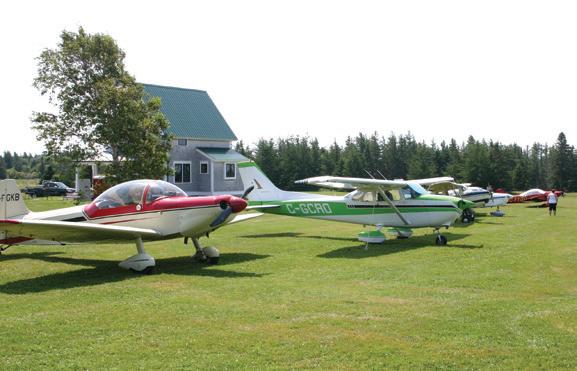
CCA3 is host to many aircraft types, including helicopters. This Schweizer 269C flew in from Charlottetown.

as a mechanical specialist, writing the repair manuals for all the machinery. He continued to work on aircraft while working at Polaroid. In 1985, he retired from Polaroid and Jimbo moved with Jean to Southwest Florida, where there was a fledgling airpark being built at the time. Theirs was the second house built in the new airpark, and Jean still lives there to this day.
In 1987 the Whittys bought an adjacent farm in Cable Head, which now gave them a total of approximately 300 acres. Jimbo hired bulldozers, road graders, steamrollers and surveyors to make a second runway perpendicular to the original runway. Then, in 1989, with all the adjacent land, he subdivided into 50 building lots to create the first airpark of its kind in Eastern Canada. The airport was officially registered as an aerodrome, and the Department of
Transport designated it as CCA3.
Overall, there was no master plan; it was just for the love and promotion of aviation. When the Prince Edward Island Flying Association was formed, Jimbo of course became a member immediately. He always loved flying into Charlottetown to meet the club members every Saturday morning for breakfast at their favourite restaurant. Those members became some of his closest friends. The club members reciprocated by flying out to Cable Head for a barbecue, or just to visit “Farmer Jim” any day of the week.
The Whittys would fly their Cessna 182 from Florida to P.E.I., but in 2017, at the age of 76, Jimbo thought it was time to get a multi-engine aircraft. He bought a beautiful 1970 Cessna Skymaster 337G. His son Michael, being a flight instructor, trained him and got him his
multi-engine and instrument ratings and his commercial licence in the 337. This made the trips to P.E.I. much faster, safer and easier.
Jimbo and Jean were devastated when Covid struck, unable to travel to their beloved P.E.I. home. The second year of Covid, the government of P.E.I. granted approval for them to enter the province. They were allowed to fly nonstop to Charlottetown to clear border formalities but then had to continue straight to the Airpark for the mandatory twoweek quarantine. This was all approved during a time when no other visitors were allowed on P.E.I., only truckers and essential businesspeople.
There were several reasons the Whittys were granted permission to enter the province. Cable Head Airpark runways were frequently used by the Canadian Coast Guard for positioning and prac-
tice, and in emergencies too. Medevac helicopters were utilizing the runways in critical situations. In addition, several flight schools from the three different adjacent provinces were using the airport for practice and navigation.
Jimbo was also very proud that his passion for aviation turned into something that boosted and helped the surrounding communities. It was not uncommon for Jimbo to assist local fishermen in locating nets that had gone adrift. He helped local farmers search the boundaries of their farm, or any other support that could only be done from the air. He was happy to offer these kinds of support to local residents — he would never say no.
Today it is one of only three registered aerodromes on Prince Edward Island, and one of only a handful of fly-in communities across the entire country. It has two rolled grass runways, one 3,200 feet and the other 4,200 feet. Everything from small jets to big turboprops, along with all types of private aircraft, regularly use the runways. There have even been hang-glider and paraglider pilots who,
with the assistance of winches, use the airport.
There’s so much that could be written about Jimbo’s significant life in, and contributions to, aviation. It would be impossible to cover even a fraction of his aviation life in so few words. He has mentored many people who had never been in an airplane until they met him. People who went on to become airline captains, a commander of Air Force Two in the U.S. military, corporate pilots, private pilots and the list goes on. He also helped people get into extremely successful careers in aircraft maintenance positions as well as ownership. He truly followed a path that changed so many people’s lives for the better both in aviation and in general.
Jimbo was a very generous person, always kind, full of life, loved by many. Sadly, Jimbo passed away peacefully in January 2023 at his home in Florida. No surprise, his ashes are buried under one of the old apple trees at their farmhouse at the Cable Head Airpark.
In 2024, the P.E.I. Flying Association dedicated a plaque to Jimbo, honouring
his contributions to aviation. The plaque is fittingly attached to the windsock at the Airpark for everyone who flies in to read. Shortly before that, the FAA presented Jimbo with two plaques unbeknownst and unsolicited. One was for 50 years flying without an accident; the second one was for 50 years of aviation maintenance and inspection without an accident. Jimbo’s spirit is alive and well with his legacy Cable Head Airpark. He is fondly remembered by all and he is talked about often.
The future of Cable Head Airpark remains in good hands and is operating smoothly with Jean and son Michael at the yoke. Being a small unique community, the owners band together and pitch in, contributing to whatever is necessary. It’s a community that Jimbo built for aviation enthusiasts from all over North America. What better legacy could a man leave while pursuing his passion in life?
All are welcome to come to Cable Head Airpark and visit. Information about the airpark and contact information is available at www.buypeirealty.com/ airpark.

“TODAY [CABLE HEAD AIRPARK] IS ONE OF ONLY THREE REGISTERED AERODROMES ON PRINCE EDWARD ISLAND, AND ONE OF ONLY A HANDFUL OF FLY-IN COMMUNITIES ACROSS THE ENTIRE COUNTRY.”

For over 80 years, the content of From the Ground Up as a literary benchmark that defines the multitude of theories associated to aeronautics. It describes the practices necessary to achieve the highest levels of distinction as safe, competent and skilled life-long aviators.
Through its evolving editions, many generations of readers have used this award-winning title as the foundation of their introduction to the concepts that require thorough understanding in advance of the sought-after hours of flying enjoyment that are the ultimate goal of all who seek to earn their wings and expand their knowledge of flight theory and practice.
The content of From the Ground Up may, at times, seem complex, but the pathway to learning the fundamentals of aeronautics is one that reaps much in the way of personal reward for all who pursue the goal of thoroughly understanding the subject. Indeed, it was by design that its original author, “Sandy” A. F. MacDonald — a man recognized as a “father” of what still stands today as the standard curriculum for ground school instruction — devised this aeronautical textbook to be comprehensive and current while conveying its material in such a way as to enhance the reader’s understanding of every written word.
Not one to permit his vast experience to allow for foregone conclusions, “Sandy” MacDonald’s meticulous care in the creation of From the Ground Up has become the hallmark for its widespread use and respect as the reference textbook of choice in hundreds of flying schools throughout Canada and around the world.
Its latest edition is the 30th Edition. A French-language version is also available under the title Entre Ciel et Terre Totalling over 400 pages of in-depth content formatted in a sequential, logical and easy-to-read fashion, the publication boasts over 360 graphics, charts, diagrams, illustrations and photos. An additional full-colour navigation chart and a sample weather chart are included.
All chapters are current in the latest technological and legislative aeronautical matters and cover such topics as The Airplane, Theory of Flight, Aero Engines, Aeronautical Rules & Procedures, Aviation Weather, Navigation, Radio & Radio Navigation, Airmanship, Human Factors, and Air Safety. From the Ground Up also includes an extensive index, glossary and a 200-question practice examination.
Since the 1940’s, virtually every student — civilian, military, commercial, recreational — who has ever learned to fly in Canada has used From the Ground Up as the primary ground school textbook from which they’ve learned everything one can learn about aeronautics, and about flying. Referred to as “the Bible” of ground school instruction, and updated with every frequent re-print, From the Ground Up has long been considered an essential resource for all with any interest whatsoever in the theory of flight, and in the practice of aviating.
Also available from Aviation Publishers
• From the Ground Up Workbook
• Canadian Private Pilot Answer Guide
• Canadian Commercial Pilot Answer Guide
• Canadian Instrument Pilot Answer Guide


• Instrument Procedures Manual
• Flying Beyond: for Commercial Pilots
• Unmanned: for RPAS Studies
• Flight Test Notes: for Flight Test Prep
For more information about all of our titles, visit us on the web or contact your local pilot supply

BY NAT REED
Not much remains of the tiny northern Alberta hamlet of Little Red River; just a few scattered buildings perched on the banks of the mighty Peace River. In fact, it is difficult to believe that almost a century ago this obscure dot on the map was the focus of the world’s attention and its residents the subject of one of the greatest rescue missions in our country’s history. It was just before Christmas, 1928, when Hudson Bay’s Company factor Bert Logan became deathly ill after returning home from a trip to Quebec. His wife Ellen, a nursing sister of the Gray Nuns, recognized the symptoms as diphtheria and immediately sent for Dr. Howard Hamman in Fort Vermillion, several hours distant by dogsled. Ellen knew that without treatment it could cause serious heart damage and kidney failure. Dr. Hamman was quick to
respond to Ellen’s request and arrived a few hours later. Confirming that the patient did indeed have diphtheria, he sadly informed them that there was little to be done for him, for the infection had already spread too far.
One could well imagine the anxiety felt by the doctor at this time, for he knew that left untreated, diphtheria could decimate the entire community. Although he had a small supply of diphtheria antitoxin, he did not have nearly enough to protect all the people in these two remote communities. He needed help from the outside world, and he needed it fast, but the nearest telegraph office was in Peace River, more than a week’s journey by dogsled. He knew, too, that even once the telegram was sent, the precious serum would still have to be delivered from far-off Edmonton, and by then it would be far too late for many.
At this point, two seasoned woodsmen, Joe Lafleur and
“DIPHTHERIA. FEAR


his son-in-law William Lambert, courageously volunteered to make the perilous trip to Peace River. Packing their dogsled with duck-feathered robes, bearskins and enough food for a week, they’d barely left Fort Vermillion when disaster struck. Lafleur narrowly escaped death when he broke through the ice and plunged into the frigid waters of the Peace River. Hurrying the stricken man back to Fort Vermillion, the men were forced to delay their trip for another three days while Lafleur recovered.
Braving a blizzard and temperatures hovering around -50˚C, the two men once again set out and, in only about a week’s time, made the 280-mile trip to Peace River, arriving on New Year’s Day — an outstanding achievement given the circumstances. There, a telegram was sent to the Deputy Minister of Health, Dr. Malcolm Bow in Edmonton, “DIPHTHERIA. FEAR EPIDEMIC. SEND ANTITOXIN.”

When Dr. Bow received the telegram, he immediately contacted Commercial Airways Ltd., a small flying company based in the city. The company, owned by bush pilot Wilfrid (Wop) May and his partner Vic Horner, assured Dr. Bow that they would be prepared to leave for Fort Vermillion the following morning.
Even during the late 1920s, when aviation was in its infancy, Wop May was already a living legend, especially among his fellow Albertans. A barnstormer and flying ace of the First World War, he had gained worldwide fame a decade earlier as the pilot being pursued by the famous Red Baron when the German ace was shot down and killed May and Horner’s plane was a two-seater Avro 594 Avian IV. With a 85-horsepower Cirrus II engine, its top speed was 105 miles per hour (169 kph), with a range of 360 miles (580 km). An Avro had already made headlines the previous
August when Amelia Earhart used one to become the first female pilot to fly solo across North America and back.
Wop and Vic met with health officials at the Edmonton airport on the morning of January 2, 1929. With the thermometer reading -28˚C, the two flyers came dressed in heavy coats, pants, scarves, goggles, felt boots and the traditional flyers’ cap with earflaps. Dr. Bow and his medical staff placed 500,000 units of the serum (enough to treat 200 cases) in a blanket with a charcoal heater to keep them from freezing. With a pocketful of chocolate bars from his wife Vi, Wop checked his map and compass one last time, pointed the Avro into the wind and driving snow and headed north on one of the most memorable and treacherous adventures of his life.
The task facing the two men was enormous. To begin with, unlike 21st-century bush planes, the Avro Avian featured two wide-open cockpits with nothing to stop winter’s wind-driven, ice-laced cold from causing them excruciating discomfort. The men were exposed to freezing temperatures, snow and biting headwinds which greatly reduced visibility, fog, a low cloud ceiling, and daylight which lasted only until about 4:00 pm — perishing conditions. An additional concern was the fact that on their return trip they would have to rely on automobile gasoline, for no aviation gasoline would be available where they were going. Car gasoline is not refined enough for aircraft use, and is most unreliable, especially in extremely cold weather. To partially compensate for this, they managed to store an additional eight gallons of airplane fuel in the baggage compartment.
The fact that the plane was only equipped with wheels was also a major concern. Landing in deep snow would not only be potentially perilous but would also make taking off almost impossible. Alternatively, they hoped that landing on the windswept surfaces of lakes and rivers would give them a fighting chance of success.
As Wop and Vic taxied down the runway, an Associated Press reporter was there to keep the rest of the country apprised of the dramatic events unfolding in northern Alberta:
“THE MEN WERE EXPOSED TO FREEZING TEMPERATURES, SNOW AND BITING HEADWINDS WHICH GREATLY REDUCED VISIBILITY, FOG, A LOW CLOUD CEILING, AND DAYLIGHT WHICH LASTED ONLY UNTIL ABOUT
4:00
PM — PERISHING CONDITIONS.”


“Captain Wop May, former Canadian Army pilot, with Vic Horner as passenger, took off yesterday with 500,000 units of antitoxin in response to an appeal for help from settlements at Fort Vermillion and Little Red River. They faced the task of locating the posts in snow-covered forests and landing where no plane had been known to have flown before.”
The two aviators must have been wondering right from the start if their mission was jinxed, for they had only been in the air for a short time when the blanket protecting the serum was set on fire by the charcoal heater. May somehow managed to land the plane safely and put the fire out before both the serum and airplane were destroyed. To protect the antitoxin, the men gamely stuffed the containers into their pockets, armpits and groin areas — anywhere they might be kept warm.
As daylight faded, Wop knew they had to find a place to put down soon, for it would be impossible to maintain one’s bearings when flying over such a wilderness in the dark. Checking his map, he decided that McLennan Junction would be their best bet for a stopover. Fortunately, the people of the village were aware of the mercy flight heading in their direction and wisely decided to clear a landing strip for the plane on nearby Kimiwan Lake. To the delight of the locals, Wop took advantage of their thoughtfulness and set his plane down on their makeshift strip just as darkness was setting in. Draining the plane’s oil, they carried it and the precious serum into the warmth of a nearby building for the night. Their flight time from Edmonton was under four hours and, in that time, had covered 267 miles in temperatures hovering around -30˚C. (without allowing for the windchill factor).
Shortly after sunrise (9:40 am) the next morning, they again took to the air. Following the railroad line, they arrived in Peace River just after 10:30 am to refuel. Forty-five minutes later were once again in the air.
Leaving Peace River gave its citizens an experience they would never forget. As the plane lifted off the ice for the last lap of their journey, Wop realized that they couldn’t get


enough altitude in time to clear the railway bridge over the river. In only an instant he made the decision to fly under the bridge, then up and away on the other side, to the cheers of the entire community below them.
Surely by this point Wop and Vic must have been wondering what would happen if they crash-landed in such a remote area. How long would it take a rescue team to find them? Where would such a search party even begin to look in such a vast wilderness, especially without even having access to a search plane?
When they arrived at their final destination of Fort Vermillion four hours later, they could see that the citizens had already cleared a landing strip for them on the Peace River. Breathing a sigh of relief, Wop brought the plane safely down and taxied over to where the grateful crowd had assembled. They had made it. As the two aviators climbed slowly from their cockpits, the strain and exhaustion were plain to see through their snow-encrusted faces. All that now remained of their historic odyssey was for Dr. Hamman to transport the serum back to Little Red River and its desperate citizens.
For Wop and Vic, however, their adventure was far from over. Their biplane did not have nearly enough fuel to get them safely back to Edmonton, so they reluctantly filled their 20-gallon tank with all that was available — automobile gasoline, knowing full-well that it would likely plug their engine.
Early the next morning they left Fort Vermillion for home, with the prayers and good wishes of the community following them. Although the town of Peace River was only about 50 miles away, they were just barely able to coax their sputtering aircraft onto the makeshift landing strip. Exhausted and chilled to the bone, the two men were helped from the plane and practically carried into the warmth of the nearest building to thaw out. Then for the next two long days, Wop and Vic laboured over their plane’s stricken engine before finally getting it back into flying shape.

Wilfrid (Wop) May (1896-1952)
The last leg of their journey to Edmonton took every ounce of courage and resolve they could muster. With visibility greatly diminished because of fog and snow, the plane had to be kept at less than 100 feet from the ground for most of the way. Still, for the next several long hours, they somehow managed to overcome every obstacle that the northern winter was able to throw at them.
When they finally reached their destination, the faces of both men were covered with large blisters and their extremities badly frostbitten. It was here, however, that these intrepid airmen received one of the greatest receptions the city has ever seen. More than 10,000 people eagerly awaited them at the airport, including the city’s mayor. There, he presented both Wop and Vic with engraved watches. Wop’s read, “Presented to Wop May as an appreciation for the Epic Flight with Vic Horner to Fort Vermillion — January 2, 1929 — From the Boys.” They were later also awarded the Trans-Canada Trophy (also known as the McKee Trophy).
The rescue mission undertaken by Wop May and Vic Horner was nothing short of miraculous. As a result of their courage and sacrifice, only about a half-dozen people contracted diphtheria, with only the unfortunate Bert Logan succumbing to the deadly infection. The mercy flight covered 1,240 miles (2,000 km) with a total flying time of over 14 hours. Wop and Vic sacrificed themselves, enduring unbelievable hardship to fulfill their life-or-death mission, but in so doing, saved many others from enduring an even grimmer fate.
Afterword
To improve communication in this remote area, Prime Minister William Lyon McKenzie King had a telegraph line extended to Fort Vermillion the following year. At the same time, Dr. Hannon also became a ham radio operator, offering another means of reaching out for help in case of such an emergency.
Resources
Anderson, F.W., The Death of Albert Johnson: Mad Trapper of Rat River. Heritage House Publishing, 1967.
Reid, Sheila. Wings of a Hero: Ace Wop May. Vanwell Publishing Limited, 1997. The Wop May Chronicles. Stories About Wilfrid Reid (Wop) May: www.wopmay.com
Wop continued to inspire others with his courage and devotion to both his country and fellow countrymen. Three years after his mercy mission to Fort Vermillion, Wop made headlines by using his plane to help track down the “Mad Trapper of Rat River.” In the Second World War he again served his country, this time as commander of No. 2 Air Observer School near Edmonton as well as supervising other training schools in Western Canada. He was also instrumental in developing pararescue teams to aid pilots downed in remote areas. He died of a heart attack while hiking with his son Denny at the age of 56.
Vic Horner (1897-1955)
Like his good friend Wop, Vic had earlier been a veteran of the Great War where he was severally wounded at the Battle of the Somme. The military continued to be an important part of his life, serving in the reserves and attaining the rank of Captain in the Royal Canadian Artillery.
Dr. Howard Hamman (1901-1987)
Dr. Hamman practiced medicine in the north for almost 25 years before developing tuberculosis and being hospitalized in the Baker Sanitorium in Calgary.
Dr. Malcolm Bow (1887-1982)
Dr. Bow served as Alberta’s Deputy Minister of Health from 1927 to 1952. During his tenure, he expanded healthcare services in remote areas of the province. Dr. Bow also served as an associate professor of public health at the University of Alberta.

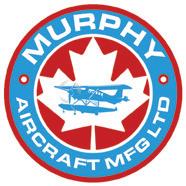
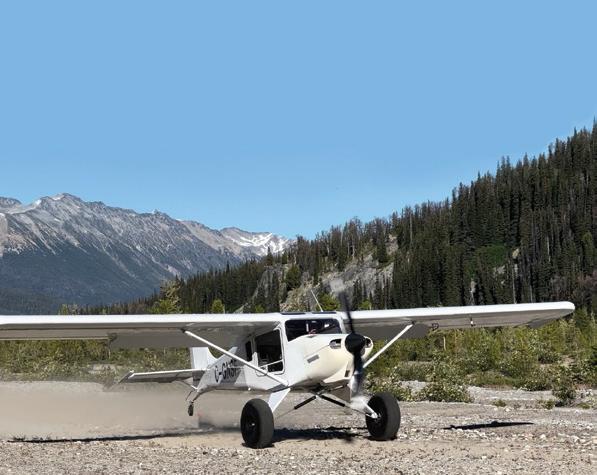





This book is a compelling tribute to Clarence Alvin “Duke” Schiller, an under-celebrated pioneer in the field of aviation. It spans Schiller’s early life in Canada, detailing his journey from his birth in Iowa to his family’s resettlement in Cooksville, Ontario, and outlines his significant contributions to early aviation, including his time as a bush pilot and his service in multiple air forces.
AUTHOR: Tom Douglas
PRICE: $38.45 (includes shipping in Canada)

The controversial cancellation of the Avro Arrow continues to inspire debate today. When the program was scrapped in 1959, all completed aircraft and those awaiting assembly were destroyed, along with tooling and technical information. Was abandoning the program the right decision? Brimming with information, this new edition also brings to light recently discovered documents that answer whether the U.S. government wished Canada to continue the development of what was considered the world’s most advanced interceptor aircraft. 323 pages with photos.
AUTHOR: Palmiro Campagna
PRICE: $49.99 (includes shipping in Canada)

The Found family’s name is famous among bush pilots worldwide for having built a tough little freight-hauling aircraft designed for hard service in Canada’s wilderness. The author’s father, Sherman, along with his uncle Nathan (Bud) Found, and with financial backing from department store magnate John David Eaton, took on the Herculean task of gaining FAA certification for their dream aircraft.
AUTHOR: S.R. (Rick) Found
PRICE: $26.50 (includes shipping in Canada)

Bush pilot Scott Brandon forms a volatile alliance with Catherine McGregor, an executive jet pilot from California. Together they search in the Yukon for an old Lufthansa airliner that vanished in 1937. Their path of discovery takes them from the genesis of the Third Reich to the boardrooms of an American empire. Like mariners of old, a bond occurs understood only by those who share a passion for flight. NEW
AUTHOR: Michael Bellamy
PRICE: $44.50 (includes shipping in Canada)

The working life of the distinguished surveyor Guy Blanchet reflects the story of northern Canada in the first half of the 20th century. Beginning his career in the boreal forests of Alberta and Saskatchewan, using pack horses and dog teams, Blanchet went north to map large areas of the Barrens by canoe, and soon became caught up in pioneer northern aviation.
AUTHOR: Gwyneth Hoyle
PRICE: $31.95 (includes shipping in Canada)

The tragic fate of the British airship R101 — which went down in a spectacular fireball in 1930, killing more people than died in the Hindenburg disaster seven years later — has been largely forgotten. In His Majesty’s Airship, S.C. Gwynne resurrects it in vivid detail, telling the epic story of great ambition gone terribly wrong. She was the lynchpin of an imperial British scheme to link by air the far-flung areas of its empire, from Australia to India, South Africa, Canada, Egypt and Singapore.
AUTHOR: S.C. Gwynne
PRICE: $36.50 (includes shipping in Canada)
NEW PRICE

This is a beautifully produced coffee table-size book. Solid Canadian history from start to finish, this authoritative book revives a key theme in Canada’s aviation heritage in a landmark year — the 100th anniversary of the end of the First World War.
AUTHORS:
Larry Milberry and Hugh A. Halliday
PRICE: $59.50 (includes shipping in Canada)

Air Canada: The History explores a modern miracle that has made commercial air travel in our country an everyday occurrence. The airline was born in 1937 as “Trans Canada Airlines,” a ward of the Canadian National Railway. Renamed “Air Canada” in 1964 to reflect its status as a jet-age airline, it survived devastating air crashes, financial deficits, self-serving politicians, strikes, privatization and the Airbus scandal. This is its story.
AUTHOR: Peter Pigot
PRICE: $49.95 (includes shipping in Canada)

One of only five Martin Mars originally built, the giant flying boat Hawaii Mars is destined to join the B.C. Aviation Museum after its final flight. Join us on a historical journey through 65 years of operations, from 1945 U.S. Navy transport to 21st century initial attack firefighting.
AUTHORS: Wayne Coulson & Steve Ginter
PRICE: $32.00 (includes shipping in Canada)

THE ROYAL CANADIAN AIR FORCE AT 100
In Canada’s Air Force (hardcover), historian David Bercuson shares the history of the first one hundred years of the Royal Canadian Air Force, from its inception in 1924 to its centennial in 2024. Drawing on memoirs, diaries, unpublished histories, archival sources, interview transcripts and standard reference works such as The Bomber Command War Diaries, Bercuson traces the history of the RCAF as not only a fighting force but also a human institution.
AUTHOR: David J. Bercuson
PRICE: $66.50 (includes shipping in Canada)

This remarkably objective biography, written by Bishop’s son, is a warmhearted, entertaining and often surprisingly outspoken account of the escapades and heroics of a man of great courage. Eddie Rickenbacker once said, “Richthofen usually waited for enemies to fly into his territory; Bishop was the raider, always seeking the enemy wherever he could be found... I think he’s the only man I ever met who was incapable of fear.”
AUTHOR: William Arthur Bishop
PRICE: $30.95 (includes shipping in Canada)

The Contras, the Sandinistas – and the Canadians? A gripping story of how a kid from Richmond, B.C. became a Canadian Forces pilot and deployed to Central America to fly helicopter missions at the end of the Contra War. ‘Loach pilots’ were born in the Vietnam War and were a rare breed by the early 1990s. Carnegie’s first tour was flying the LOH (Loach) CH-136 Kiowa helicopter when he was sent to Honduras and Nicaragua in support of the Contra demobilization.
AUTHOR: Bruce L. Carnegie
PRICE: $30.45 (includes shipping in Canada)

The history of air accidents is a harrowing one. Yet today flying is the safest mode of transportation, thanks in no small part to the work of crash detectives. Whenever a plane falls from the sky, the investigators pick through the wreckage for the clues they need to decipher what happened to that flight. Before the invention of the ‘black box’ and the evolution of forensic accident investigation, the causes often remained a mystery.
AUTHOR: Peter Pigott
PRICE: $46.95 (includes shipping in Canada)

In the early 20th century, Canada’s North was a mystery. In 1874, Canadian Prime Minister Alexander Mackenzie agreed to take up sovereignty of all the Arctic from the British, if only to keep the United States and Tsarist Russia out. But as the nation expanded east and west, the North was largely forgotten. From Far and Wide recounts exclusively the historic activities of the Canadian military in Canada's North. (Hardcover book – 312 pages with photos.)
AUTHOR: Peter Pigott
PRICE: $49.95 (includes shipping in Canada)

The extraordinary history of Canada’s airshow teams is recorded in its entirety. Meticulously researched by a former Snowbird team leader, this 768-page hardcover book documents the scores of Canadian military air demonstration teams that have thrilled millions of airshow spectators for over 85 years. From the Siskins to the Golden Hawks to the Golden Centennaires and Snowbirds, every Canadian demonstration team is represented in the book.
AUTHOR: LtCol (Ret’d) Dan Dempsey
PRICE: $139.99 (includes shipping in Canada)

In A Most Extraordinary Ride: Space, Politics, and the Pursuit of a Canadian Dream, Garneau chronicles his ascent from a mischievous teenager and rebellious naval midshipman to a decorated astronaut and statesman who represented Canada on the world stage – both on and off the planet. With candour and humour, Garneau describes the highs and lows of his life and career, including the awe he experienced first seeing the Earth from space, in this hardcover edition.
AUTHOR: Marc Garneau
PRICE: $59.50 (includes shipping in Canada)

In the trench warfare of WWI, it was soon clear that the calvary would be of little use. Soon, lances and sabres were replaced by silk scarves and machine guns. Combat on horseback was replaced by dogfights in the air. No technology changed more in the five years of the war, and none would have a bigger impact. From Great Britain to Canada to Australia and New Zealand, new heroes took the honour and dash of the cavalry to the air in flying machines – which would change the face of war forever.
AUTHOR: Norman S. Leach
PRICE: $34.95 (includes shipping in Canada)

Throughout history, when threatened by wildfires, our only defense was to pray for rain and run – until aircraft changed the way we fight fires. Beginning with the Canadian “H-Boats” in 1924, aircraft have become indispensable in detecting and extinguishing wildfires. Fire Eaters tells the incredible stories of the Ontario Provincial Air Service, the first government aerial fire suppression organization in history; one of its pilots, Carl Crossley, who invented the water scoop-up and drop-off system; and the Canadair CL-215, the first purpose-built water bomber.
AUTHOR: Peter Pigott
PRICE: $34.95 (includes shipping in Canada)


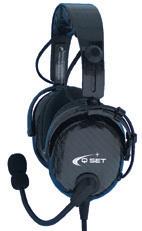









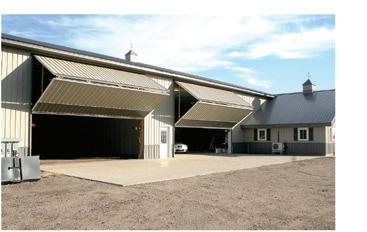



Within this month’s puzzle are the names of 10 British-made bomber aircraft (clues marked with an *), most of which flew during the Second World War or shortly thereafter. Most carried Canadian airmen.
9 Once a Chrysler, now an Aston Martin.* 10 A winner.*
14 Component of some landing gear.
15 Fan of 7 ACROSS? 16 Near Dartmouth.*
19 Changing a radio frequency.
20 Distance from a datum.
21 A major Indian city, once.*
22 Maker of the Courier airplane.
25 Major manufacturer at Mirabel.
26 Sometimes found on a cockpit instrument dial.
BY GRAEME PEPPLER
1) In the late 1920s, Fleet Aircraft built popular aeroplanes in what Canadian town? Who owned Fleet?
a) Windsor, Ontario, The Ford Motor Company.
b) Fort Erie, Ontario. Consolidated Aircraft.
c) Toronto, Ontario. De Havilland Aircraft Company.
d) Halifax, Nova Scotia. Fairchild Aviation Corporation.
2) A surface wind is blowing from 270°T. At 2,000ft, it is blowing from 280°T. What is this wind called?
a) A veering wind.
b) A backing wind.
c) A katabatic wind.
d) A wind shear.
3) George Beurling was Canada’s top WWII ace. Most of his kills occurred where, while flying what aircraft?
a) Malta; Supermarine Spitfire.
b) Egypt; Hawker Hurricane.
c) Germany; North American P-51 Mustang.
d) France; Lockheed P-38 Lightning.
4) The Engine Pressure Ratio of a jet engine is the ratio of the pressure
a) at the output of the compressor section to the input of that section.
b) of the gases in the combustion chamber to the output (exhaust) gases.
c) of the output (exhaust) gases to the input air.
d) at the high-pressure compressor section to the low-pressure section.
5) Until the twin-fuselage Stratolaunch flew in 2019, it was the longest wing-spanned aircraft to ever fly.
a) The Hughes H-4 Hercules in 1947.
b) The Airbus A380 in 2005.
c) The Boeing 747 in 1969.
d) The Antonov An-225 Mriya in 1988.
6) It is displayed on the back of a Canadian fivedollar bill, and was developed for what program?
a) The Canadarm; NASA’s Space Shuttle program.
b) The Canadarm1; NASA’s Constellation program.
c) The Canadarm2; the International Space Station.
d) The Canadarm3; the Lunar Gateway program.
7) An aircraft is in a position such that its magnetic compass points to true north. This aircraft is on
a) an agonic line.
b) an isogonal line.
c) an isoclinic line.
d) a nodal line.



For 120 years, our engines have helped shape this industry, with landmark innovations that put pilots first. The first Jet-A engine for GA, FADEC, fuel injection, turbocharging—advancements in performance and quality. Together with you, we celebrate aviation’s pioneers, and our shared journey toward the future of flight.
®: Powering Legacies Forward.